
Please send all Checks and Money orders to :
Dave Taylor P.O. Box 87 Sylvania, OH 43560
419-842-1863
Click Here to E-mail Us!
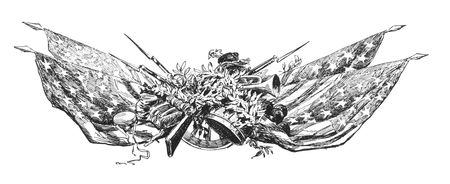

15 01
LAYAWAYS ARE WELCOME:
Need to split your order into multiple payments? No problem! A simple 20% earnest money deposit will hold your item for you.
You can then pay it off in easy installments that fit your budget.
Read Terms Here
~~~~~~~~~~

15-01-01 … Harpers Ferry 1795 Musket with 1802 Dated Lock …
A friend recently discovered this neat old musket and we have been having fun studying it. It is a 1795 Harpers Ferry musket with some interesting features. The lock is a straight-forward and very scarce 1802 dated Harpers Ferry lock. Harpers Ferry and Springfield made their own versions of the Model 1795, and 1802 is the third year of production at Harpers Ferry. As anyone can tell, however, this musket had a larger lock in it at one point. The larger inletting is rather crudely done and easily seen The gun appears to be a Harpers Ferry, though the barrel MIGHT be from a French 1766 Charleville as it is marked only with a “V” on the top of the barrel near the pan. Harpers Ferry numbered their barrels in 1802. It measures the correct 44 inches and has a bottom-mounted bayonet stud which is proper for Charlevilles and for 1802 and earlier Harpers Ferry examples. The barrels were shortened to 42 inches soon after. The stock has the sturdier lower comb stock without shallow flutes, another accepted Harpers Ferry feature, though possibly a later HF production feature. (Flayderman says Harpers Ferry never had the flutes; Moller says they did early-on, but phased them out by 1809.) The lock does not have a prominent rear tip, again proper. Moller says some did not have the tip until 1803. There is a faint trace of serial number on the buttplate tang,ending in 113. Moller states HF butt plates are numbered through 1803. When my friend found this the barrel and stock tip had been cropped a half inch and he had this professionally restored using an original piece of antique barrel. This is a pleasing 1795 HF musket in original flintlock configuration, The wood shows some dark areas, and two sets of initials carved on either side of the triggerguard, but aside from normal handling marks is very good. The barrel is a very pleasing, even plum brown. The upper band shows somewhat bright with dark spots; the middle and lower bands a more muted gray. Swivels are missing and the lug in front of the triggerguard is gone. Button-head ramrod in place, band springs, etc. Lock is functional but the pan does not center on the vent-hole … not surprising since the gun obviously has had a least one other lock installed in its history. A neat old gun
… $4,500.00
Click Here to E-mail Us!
Call us @ 419-842-1863
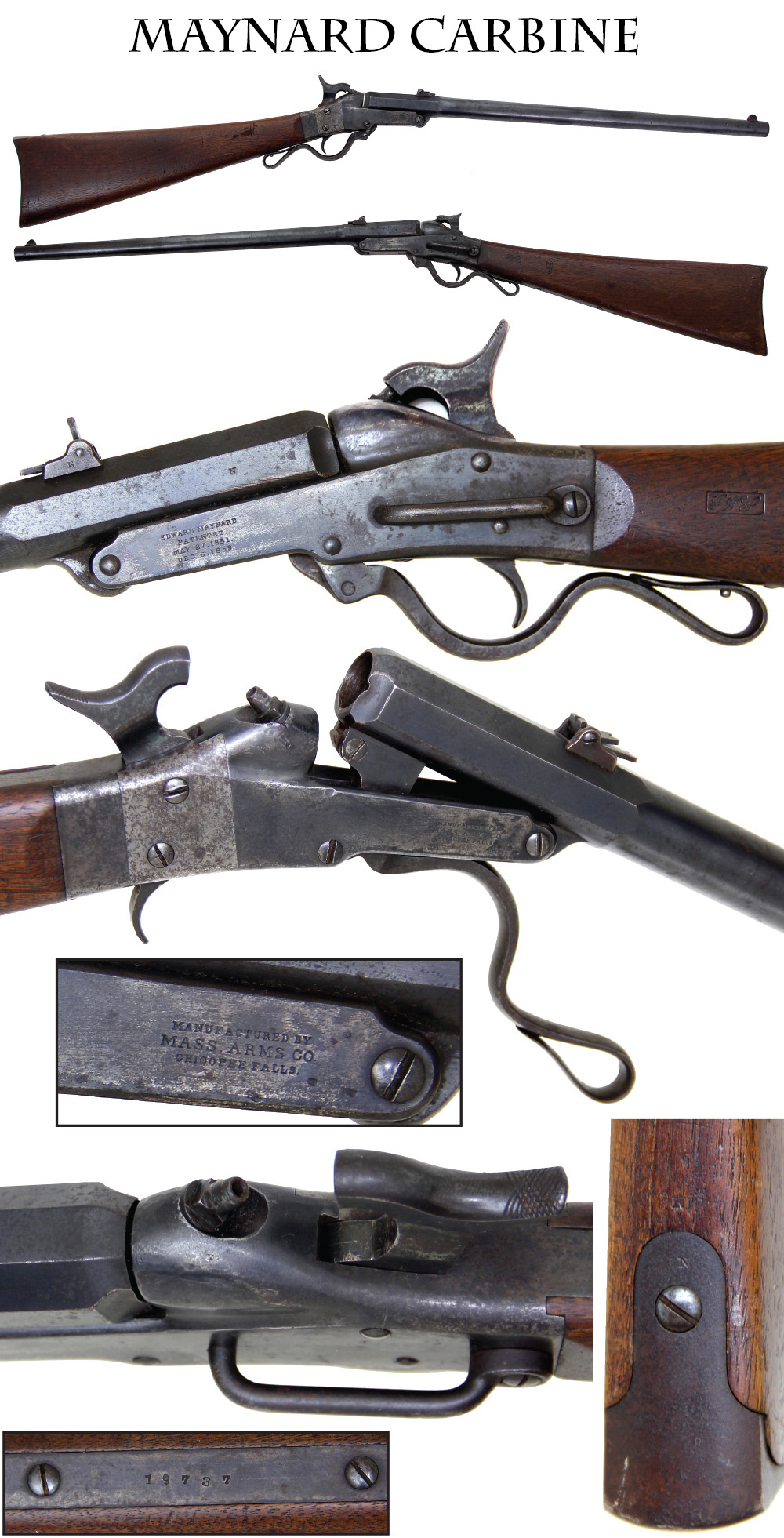
15-01-02 … Second Model Maynard Carbine a.k.a Model 1863. Maynard carbine …
serial number 19737. About “fine” condition and a solid example ofthis popular carbine. .50 caliber, single-shot. The barrel tips up for loadingthe wide based Maynard brass cartridge with a hole in its base for ignitionby percussion cap. Excellent wood with sharp edges, tight wood to metal fit, and vivid inspectorcartouches on the left side. Truly top-end wood! Has sharp Maynard patent markings on the left side ofthe frame and Mass Arms manufacturing stamps on the right. Much strong original blueon the barrel and hints of mottled fading case color on the receiver mixed with somerising brown underneath. Vertical side plate on right a tad brighter, more silverwith brown mixed. Sling bar in place, but no ring. (Easily replaced.) Small nick at base ofbarrel breech on right. A little crustiness to the buttplate from upright storage. The 9th and 11th Indiana Cavalrycarried these, as did the 11th Tennessee and others. About 20,000were made circa 1863-1865. This is a wonderful example and priced reasonably at
… $1,695.00 – SOLD
Click Here to E-mail Us!
Call us @ 419-842-1863

15-01-03 … Butterfield Pennsylvania Contract, Conversion of a Model 1816 Harpers Ferry Musket W/ Separate Percussion Breech …
Butterfield is best known for his patent self-primingpercussion system, to which he sold the rights to the US government in 1859.When war broke out he quickly formed a partnership in April, 1861, with WilliamMann to manufacture and alter arms to that priming system, and obtained acontract from the state of Pennsylvania to alter 1,000 state owned flintlockmuskets. After delivering 200 altered guns with his complex primer system, he renegotiated the contract tochange to 1,000 muskets altered with the more conventional percussion breech as seen here. 400of these were delivered in November, 1861, and the remainder in January, 1862,so these are good early war guns. Ours is a nice Harpers Ferry clearly marked on thelockplate with the Harpers Ferry eagle over “US” forward of the hammer, andHARPERS/FERRY/1836 at the rear of the lock. Has the desirable and correct BUTTERFIELD S” over “PHILADA” marking onthe barrel just forward of the breech. The unusual hammer contour is distinctive and unique to Butterfield. The wood has good color, the usualhandling dings expected on a gun that’s over 175 years old, some minor wood chipping behind thelower band, otherwise very solid with a good wood-to-metal fit and nice edges.The metal is a smooth dull cloudy gray, mixed with brown and plum hereand there. No pitting and very pleasing overall. All swivels, bands, springs and rod in place. Mechanicallyfine. A little gunk around the nipple. Smoky gray to the lockplate,hammer and bolster. Mixed assembly and conversion numbers, matching 39 onsideplate and triggerguard, a larger 141 on the buttplate tang that is likelya rack number. Correct raised bayonet stud for a special 1816 pattern bayonetwith a locking ring. With only a thousand of these produced, this is a truly scarce Civil War musket. Further, it is historically interesting having known early war delivery dates. Fresh from a local auction. I bought it “right” and can sell it “right”
… $1,150.00 – SOLD
Click Here to E-mail Us!
Call us @ 419-842-1863
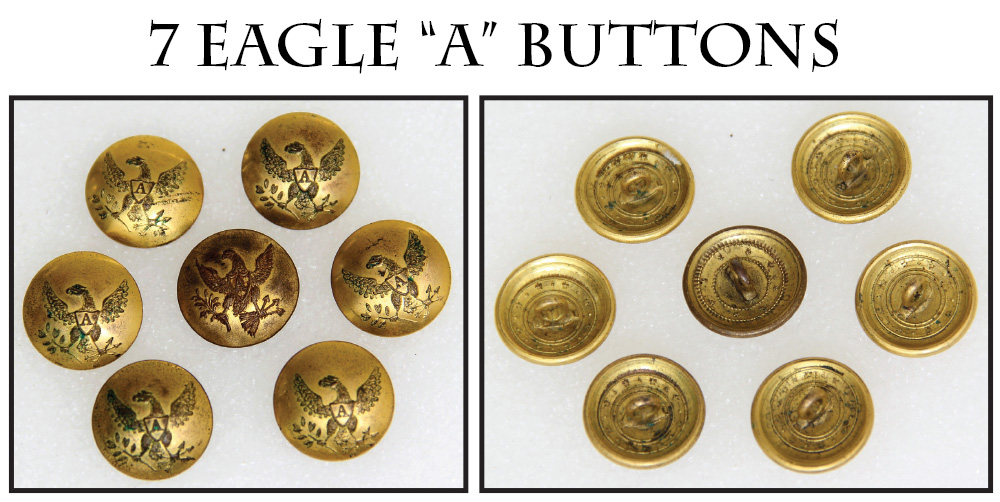
15-01-04 … 7 Eagle-A Buttons …
Early two-piece 1840s – Mexican War era artillery buttons. Each has a simple back mark of stars in a circle around the shank. Prior to the Civil War buttons with branch-of-service letters in the shield were used for both officers and enlisted men. By the time of theCivil War general service buttons (plain eagle buttons) were the norm for enlisted ranks, with the branch of service lettered buttons being worn mainly by officers. I have seven identical coat size “Eagle A” examples priced each at
… $69.00 or if the first caller wants all seven I will sell the lot for $375.00
Click Here to E-mail Us!
Call us @ 419-842-1863
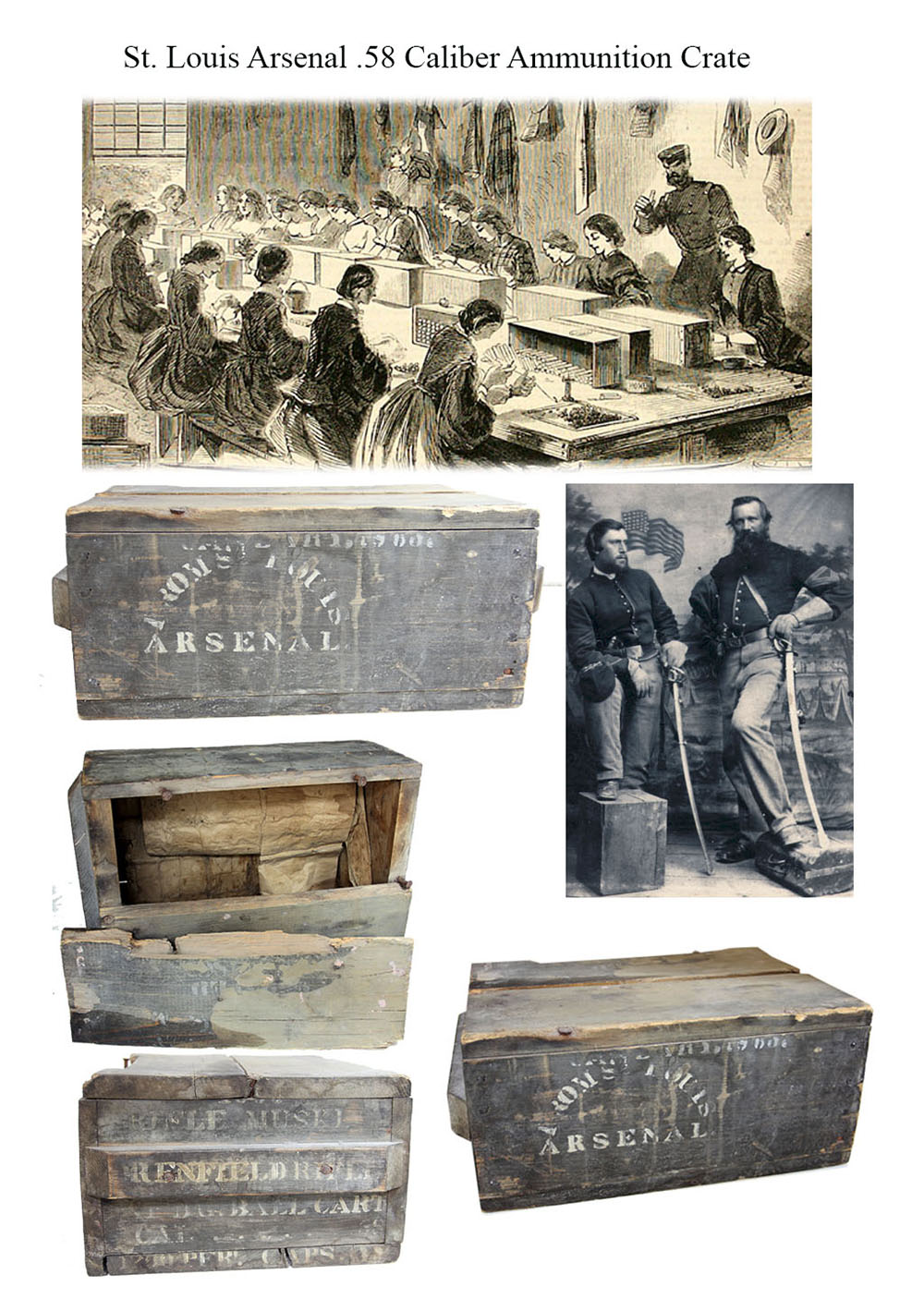
15-01-05 … Ammunition Crate … Very Very Scarce Civil War Crate For Rifle Musket Ammunition From The St. Louis Arsenal …
I love these crates! It is hard to think of anything more essential, but more “ephemeral” from the Civil War. Once opened and the ammunition doled out, what use were they? Most ended up as kindling- a few as improvised seats or tables in winter huts or a storage box for an officer. Not only are they incredibly hard to find today, most are stripped of their markings. Here is one still preserving most of its original olive drab arsenal paint and a lot of its stenciled lettering identifying the contents, plus most of the lid. Stenciled in white on one narrow end is: [1000] RIFLE MUSKE[T] [FO]R ENFIELD RIFLE ELONG. BALL CART. CAL. […] 1200 PERC. CAPS (I’ve put the partial or obliterated markings in square brackets.) On one long side you have the lower portion of what seems to be an 1863 packing date along the upper edge and below that “FROM St. LOUIS ARSENAL,” the first portion being in an arc and the word “arsenal” straight across. One of the best things about the crate is that it also preserves its lid- broken across its length, but all there and perfect for a display, looking like some anxious soldiers needed to get in there fast and had no time for fooling around with a screwdriver. Partial stencil on the top and some paint loss, some scuffing, etc., but very displayable. Even has some of what may be the original brown packing paper inside. A true Civil War rarity
… $1,450.00 – SOLD
Click Here to E-mail Us!
Call us @ 419-842-1863
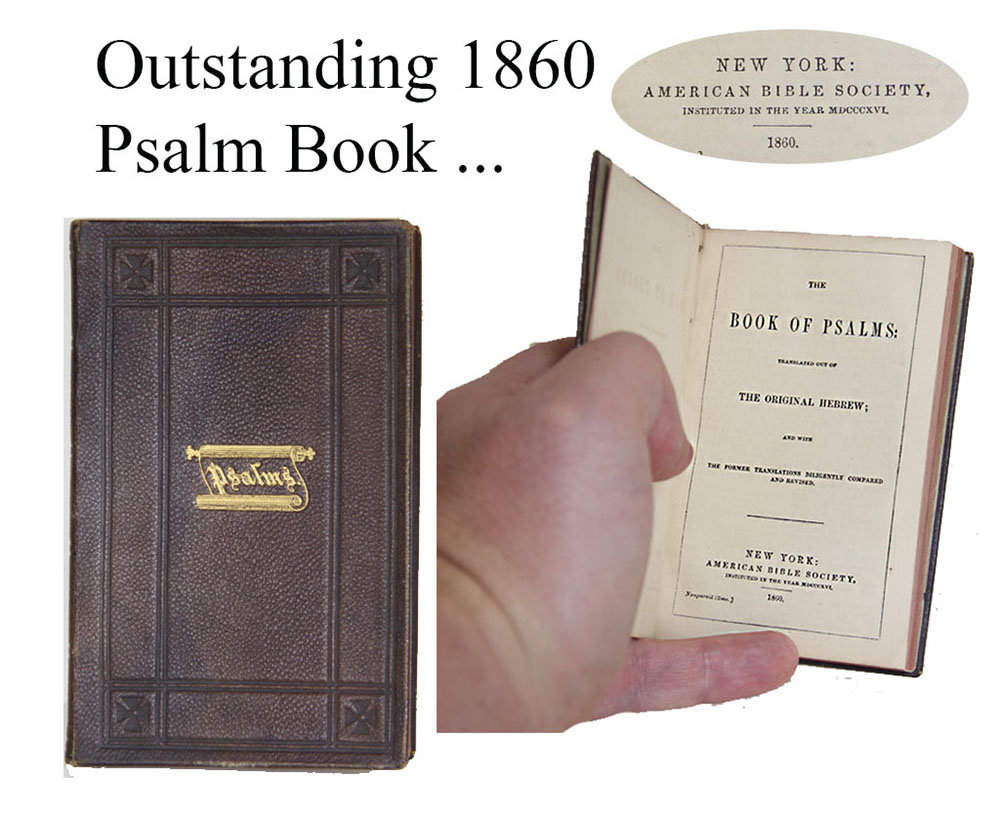
15-01-06 … 1860 Dated Pocket Sized American Bible Society Book of Psalms …
Nicely pressed leatherette cover with pebble grain surface, Maltese crosses, and gilt blind stamped “Psalms” on a scroll at center. No identification, but typical of the religious tracts, bibles and hymnals often given to departing volunteers in 1861 by loved ones and religious groups. Nice condition and a pocket size typical of those actually carried: A most affordable CW personal item
… $95.00 – SOLD
Click Here to E-mail Us!
Call us @ 419-842-1863

15-01-07 … Wonderful Identified And inscribed Wounded-In-Action Soldier’s Mess Set: A Dead-Real Period Inscription Done For The Soldier’s Second Enlistment In The Army …
Samuel H. Smith of Salem, Mass., served two hitches in the army. His first tour probably taught him the shortcomings of the various state-supplied pieces of mess equipment and either he or a loved one obtained a good quality fork-knife-spoon combination and had it inscribed with his name and date of his second enlistment: Dec. 10, 1861 / Samuel H. Smith / Co. H 19th Regt. Mass. V. Smith was likely a member of the prewar 8th Mass Militia, since he signed up with with them on April 15, 1861, the day they were called to Boston by Special Order No. 14 issued by the state Adjutant General as soon as news of Fort Sumter arrived. Two additional companies were added from other units and the regiment earned its nickname, The Minute Men, by departing for Washington on April 18, even before mustering into Federal service. They were sent immediately to guard important points, and were only actually mustered in as a regiment for three month’s service on April 30, Smith mustering into Co. I. They served until muster out on 8/1/61. Edward Hincks, Colonel of the 8th, then recruited another regiment, the 19th Massachusetts, in August. Smith must have liked his old commander, and been respected also, for he signed up again and mustered into Co. H as a Sergeant on 12/10/61, the same date on the spoon.
The 19th Mass. was served in the Peninsular Campaign and was called forward to assist elements of the Third Corps in one of McClellan’s chess-like moves to get his big guns closer to Richmond by seizing Oak Grove in front of the Federal works at Fair Oaks on June 25. Smith was wounded in the throat during the fighting and finally discharged for wounds on December 3, 1862. Smith’s wounding is mentioned in the regimental history: “On the 25th of June General Hooker asked for one regiment from Sumner’s corps to assist in the attack on the rebel lines in our front. The 19th was selected. We advanced in front of our entrenchments and were soon hotly engaged. Led on by our gallant colonel, we soon had the rebels in full retreat, and had the army advanced at that time I am confident we could have marched into Richmond in five hours, as we were only a few miles from the city. Just as we were ready to make the final charge an aid came to Colonel Hincks and said, ” You are ordered to fall back.” “What for?” said the colonel. “Don’t you see we have got them on the run ? ” But the order was peremptory and back we went. Our loss was very heavy for the short time engaged. Lieutenant Warner of Company H and several men were killed ; Lieut. J. H. Rice, Sergt. Samuel H. Smith, William R. Meldon, Benjamin Jellison and others, in all about sixty, badly wounded. While we had been under fire nearly all the time since arriving at Yorktown, this was the first square fight in which we had been engaged. We had no chance for the use of tactics as the woods were thick and we could see little of the enemy; but the officers and men behaved splendidly, and our only regret was to lose so many and accomplish nothing, an experience that the Army of the Potomac often had in the battles that followed.”
Smith returned to Salem and apparently rejoined the militia: a postwar photo shows him as Color-Sergeant holding a battleflag. He was active in the GAR and died in 1910. Smith lost or misplaced the knife section of his interlocking mess set. These were often used separately. But he kept important part and it must have been a valued memento of his service. One of our photos shows Smith with his battleflag. The other is a remarkable period photo showing a soldier proudly displaying one of these sets. Rare and historical
… $895.00 – SOLD
Click Here to E-mail Us!
Call us @ 419-842-1863
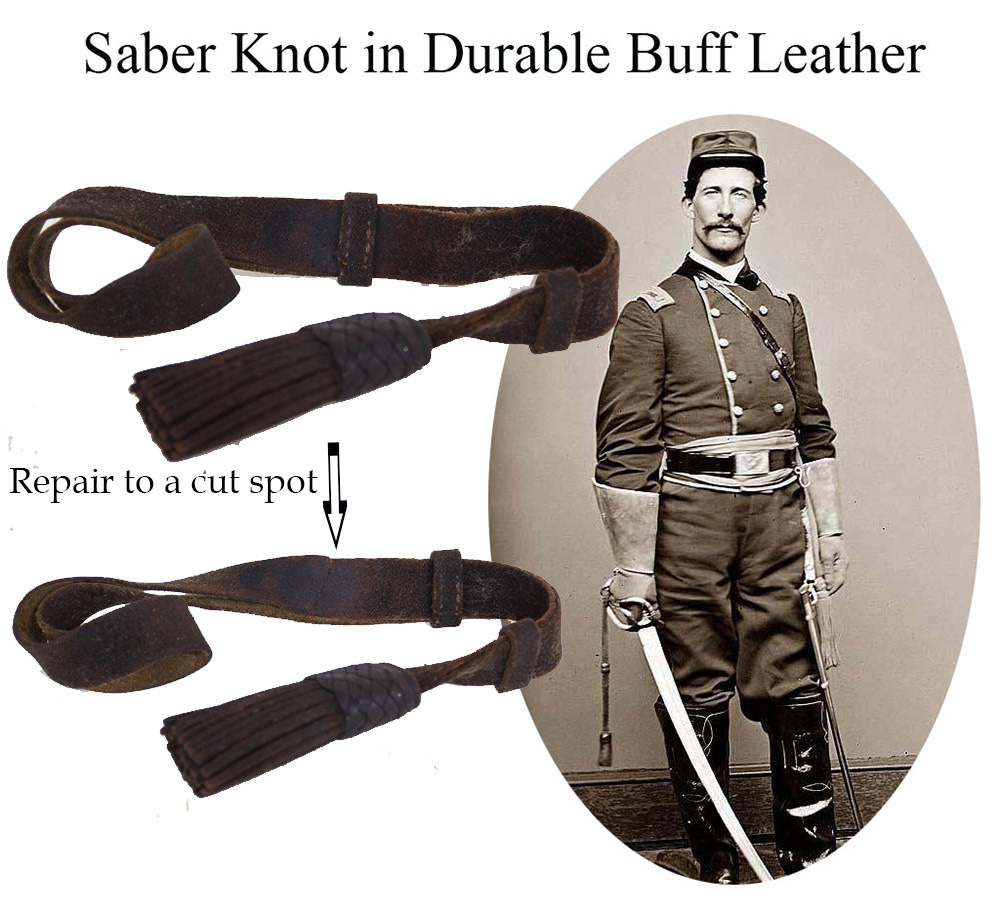
15-01-08 … Buff Leather Cavalryman’s Saber Knot …
Regulation Civil War cavalry buff leather saber knot with all its tassels and the turk’s-head braid still firmly in place. We find many, many more bridle leather knots than these very scarce buff leather examples. And most of the bridle leather specimens are beat to heck with missing tassels, flaking finish, and damaged turk’s head braid. This buff leather knot is very nice. The one fault is that it was cut at one point, probably accidentally. I had helper Tom skive the ends at the repair join, and the repair is almost invisible. It is invisible if you slide the upper keeper to that position. Also present are the two original slide tightener loops. These funcion as follow … The pointed end of the strap withdraws easily from the turks-head knot allowing it be quickly put on a saber for display I have seen more than one supposed experienced collector or dealer completely flummoxed about how these were actually mounted on a saber hilt- the pointed end of the strap is unsecured inside the turk’s head. It draws out of the head and is then wrapped around the guard where it joins the pommel cap. The strap is then inserted back into the turk’s head knot and locked in place by pushing a tassel though a small hole near the tip. It you put it on a saber, and don’t lock it with the tassel you can attach and detach it any time without trouble. The purpose of these straps was for the trooper to secure the strap around his wrist so that if his saber was knocked loose from his grasp it would not fall to the ground. but instead could be easily secured and put back into action. A very scarce piece of cavalry equipment to find in buff leather
… $365.00 – SOLD
Click Here to E-mail Us!
Call us @ 419-842-1863
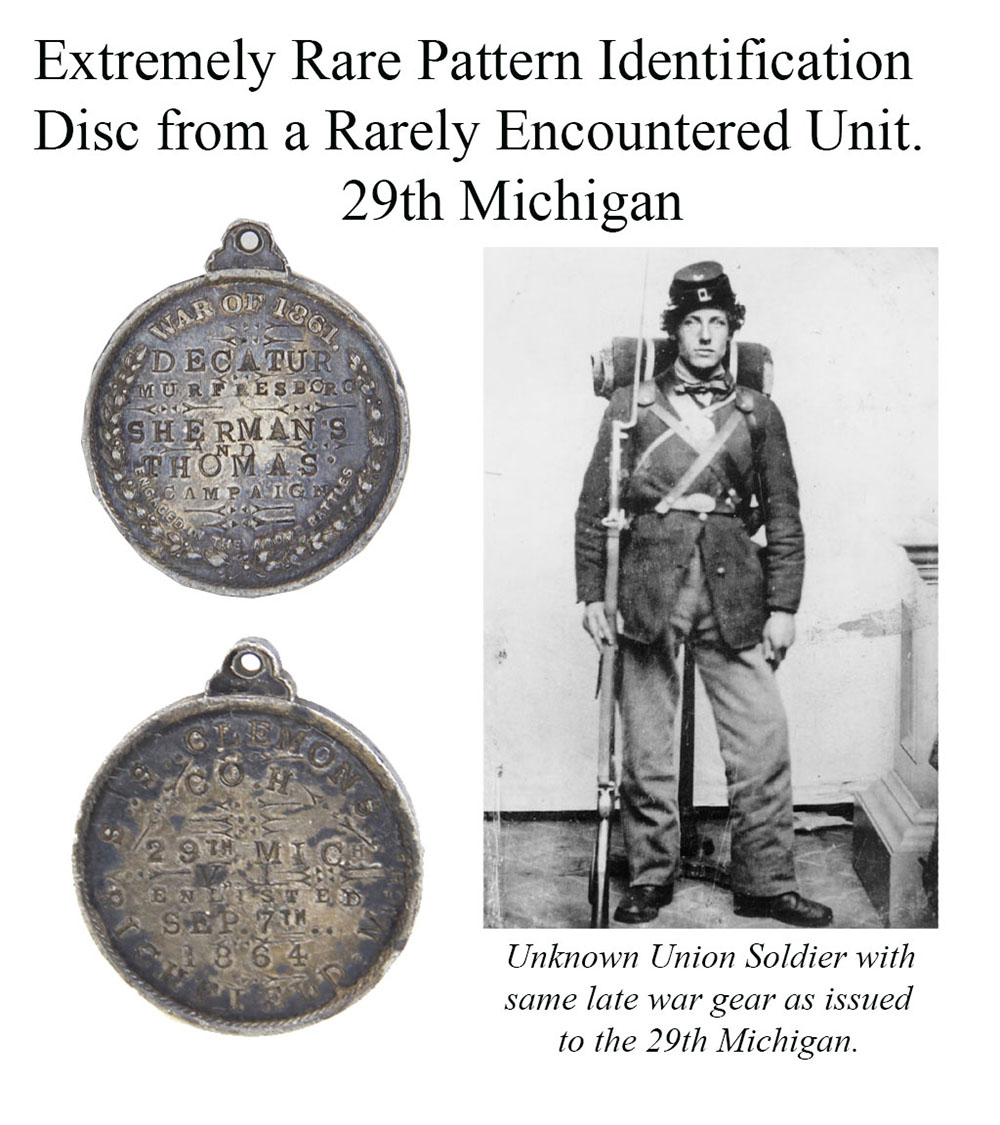
15-01-09 … Extremely Rare Pattern identification Disc From A Rarely Encountered Unit: 29th MICHIGAN …
Western theater units did not often get close enough to a major city to get the same attention from pedlars and sutlers as their eastern comrades. Consequently western theater identification discs are correspondingly rare. Here is one from the 29th Michigan, a unit that signed up in the Fall of 1864 and served in Alabama and Tennessee. On top of that, the design of the disc itself is very rare: white metal with some elements such as the wording “War of 1861” and “Engaged in the above battles” rendered integral to the medal and the other elements stamped in by sutler or merchant. This was owned by Samuel S. Clemons, who had his name, unit and enlistement date stamped on one side: S.S. Clemons / Co. H / 29th Mich. /Enlisted /Sep. 7th 1864 And then had is battle record stamped on the other: Decatur /Murfreesboro /Sherman’s / and /Thomas’ /Campaigns Clemons enlisted at age 28 in Flint, Michigan, on Sept. 7, 1864, and mustered into Co. H of the 29th Michigan as a private a week later, Sept. 14. He served until mustered out September 6, 1865, at Murfreesboro, TN, and after the war lived in Davison, Michigan. The regiment set out from Saginaw, Michigan, in early October, 1864, for Nashville and was almost immediately sent to Decatur, Alabama, where it must have been surprised to find itself soon under fire and manning the defenses of that city against a Confederate attack. Despite being raw troops, they behaved well and were credited with having helped preserve the town. The regiment spent the rest of its service in the Murfreesboro area seeing action on outpost and escort duty, hence the two specific locations Clemmons had added to his tag. The regiment was officially credited with seeing action at: Decatur, Ala., October 26, 27, 28, 1864; Overall Creek, Tenn., December 7, 1864; Winsted Church, Tenn., December 13, 1864; Shelbyville Pike, Tenn., December 15, 16, 1864; Nolansville, Tenn., December 17, 1864. They lost one officer and five enlistedmen killed in action or mortally wounded during their service. The disc has nice color: a muted silver mixed with some pewter tones and the stamping is very legible. The suspension hole is in place at the top- these were marketed with a number of different suspension pins- some plain eagle designs, others with busts of famous generals, etc. They were a purchase made by many soldiers, some of whom liked the idea of wearing a medal, and others who saw the practical aspect of identifying them in the days before dogtags were items of issue in the army. A scarce style tag for a hard-to-find unit
… $1,250.00 – SOLD
Click Here to E-mail Us!
Call us @ 419-842-1863
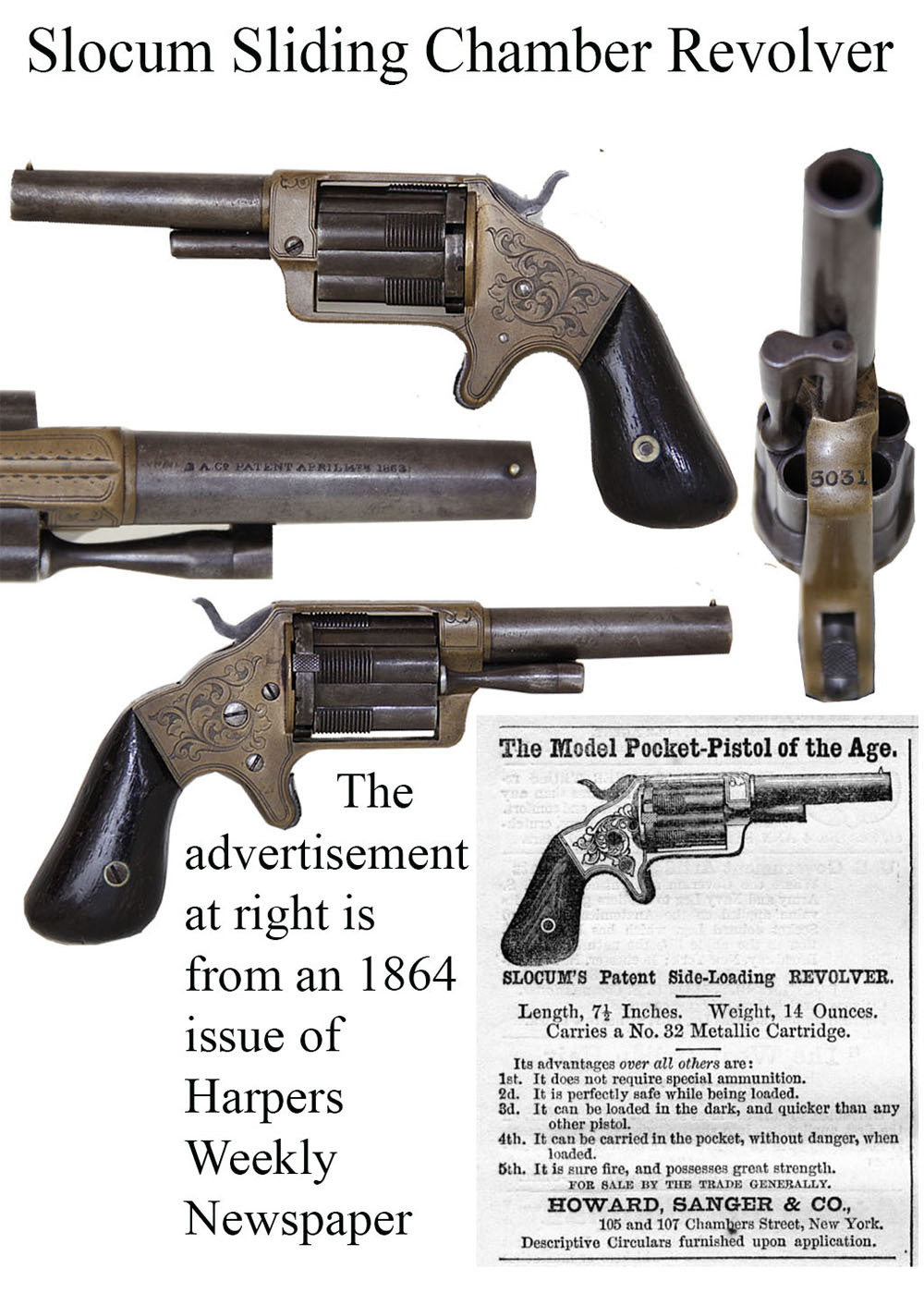
15-01-10 … Slocum Sliding Chamber Revolver …
One of the more inventive ways of getting around Rollin White’s patent for bored-through cylinders that was controlled by Smith and Wesson was the Brooklyn Arms Company’s “Slocum’s Patent Side-Loading Pocket Revolver.” This ingenious pistol was a five-shot .32 rimfire pistol that used sliding tubes within the cylinder as chambers. These slide forward one at a time over a pointed rod mounted on the right side that ejects a spent cartridge and lets the user load another round. The gun was surprisingly popular, about 10,000 of them were made from ca. 1863-1864, and had all the advantages of metallic cartridge guns: no percussion caps to mess with, waterproof ammunition, etc. My favorite plus in the advertising is number three on their list: it can be loaded in the dark.
Ours is a nice example, smooth muted silver-gray barrel with some hints of the original blue and crisp barrel markings: “B.A. Co. Patent April 14, 1863.” Very crisp serial number 5031 on the front of the brass frame. No silver wash left on the brass frame, but the brass has a very pleasing mellow patina and the leafy scroll engraving is crisp and vivid. Spur trigger, mechanically functional, front sight in place, nice dark, bag-shaped walnut grips with just some very minor dings
… $850.00 – SOLD
Click Here to E-mail Us!
Call us @ 419-842-1863
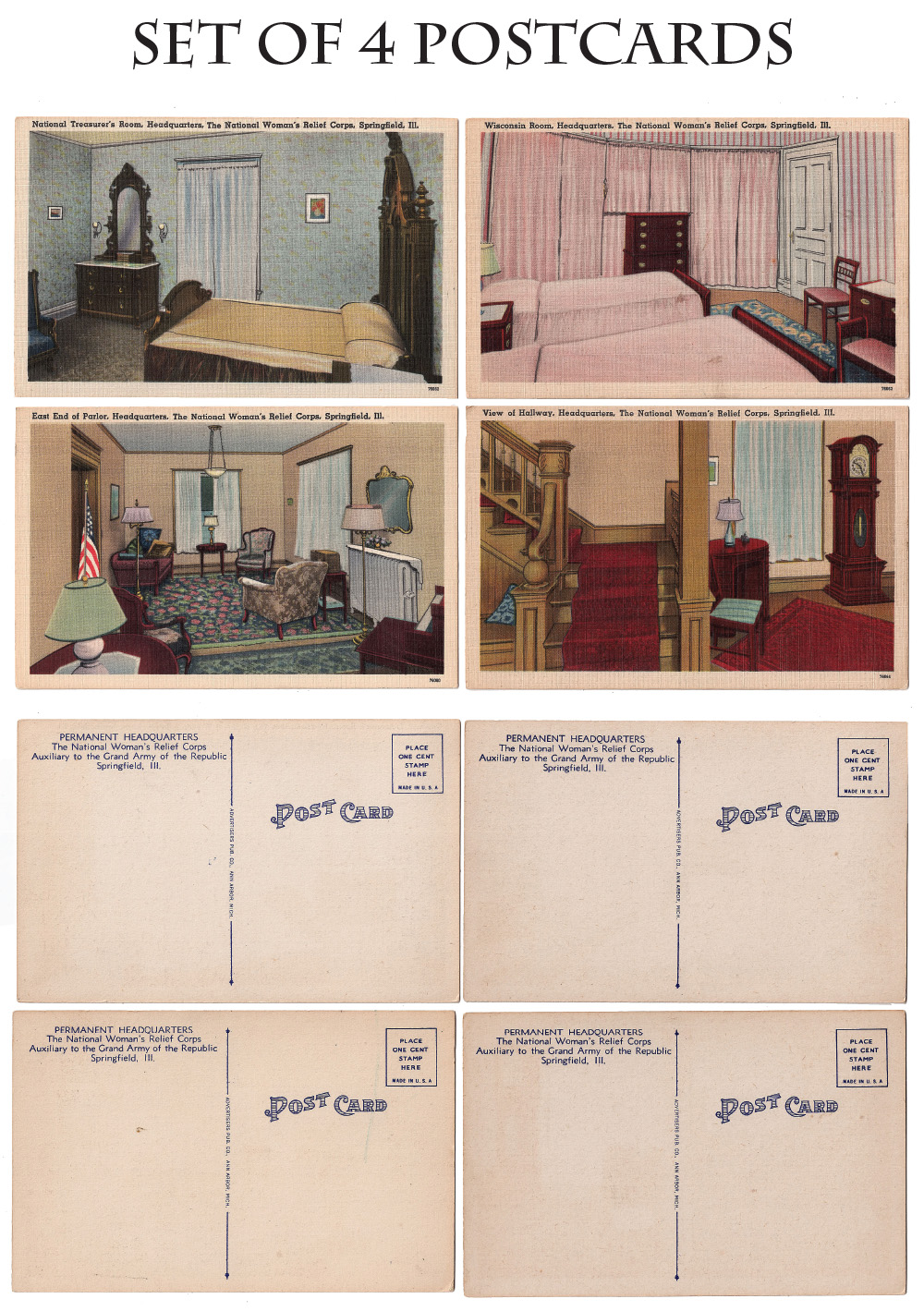
15-01-11 … Four Postcards of the Headquarters of the National Women’s Relief Corps …
The WRC was an auxiliary to the GAR, helping the veterans but possessing their own organization. Here are four colored postcard of the early twentieth century showing rooms in their “Permanent Headquarters” in Springfield, Illinois. A nice add-on to a collection of GAR and veteran pieces. Very affordable Civil War collectibles …
… $20.00
Click Here to E-mail Us!
Call us @ 419-842-1863
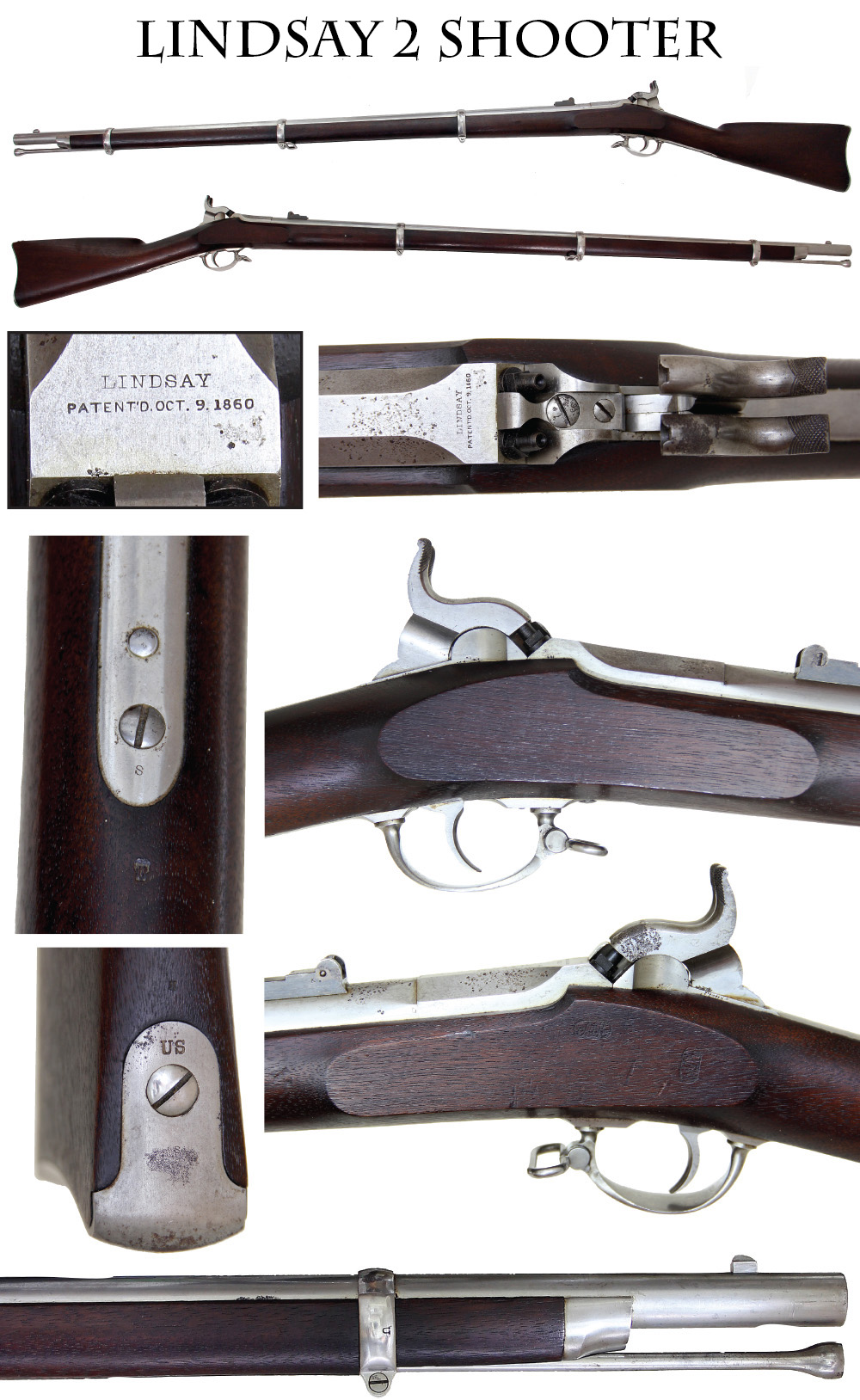
15-01-12 … Near Mint Condition Lindsay Two-Shooter Rifle Musket:
One of the most interesting Civil War firearms. Prior to the war John S. Lindsay produced pistols with John Walch using Walch’s idea of superimposed loads, one on top of the other, in the same chamber. Lindsay’s clever design was of a single-trigger mechanism that could successively fire the two superimposed shots with different hammers. He applied the design to these wonderful .58 Caliber rifle muskets and finally got an order from the US government for 1,000 trial pieces in late 1863. Samuel Norris was happy to make the rifle parts for Lindsay as he and William Clements were already producing 1863 pattern muskets for Massachusetts and had all the tools and materials needed. Lindsay was able to deliver the unique 2-shooter guns in the Fall of 1864. They were issued in small numbers for field trials in September, with some guns being issued to the 5th, 16th, and 26th Michigan infantry regiments, and also the 9th New Hampshire, who used them in action. The soldiers were not impressed, and negative reports were sent to the Ordnance Department. Consequently the balance of the 1000 2-shooter guns were not issued, but were instead put into storage … SO … as luck may have it, many survive to the present day in superb condition. This is one of the best specimens extant. Ours is an excellent++ example, near mint: Beautiful oil-finished walnut stock with razor harp edges and vividly clear inspector’s cartouches. All metal in the bright with just some minor speckling at the breech and some darker spots on the nose of the left hammer. There is one significantly pitted spot shown in the photos at the top of the breech. Otherwise the musket is about Mint. Sharp nipples. Crisp “Lindsay ‘ Patent’d Oct. 9, 1860” stamp at the barrel breech. Mechanically perfect. All bands, swivels, rod and sights in place, and NO CRACK in the wrist. We see about 50% of surviving Lindsays with cracks in the wrist… this one is perfect. A really superior example of a clever design, and one of the most interesting Civil War long arms available to collectors … even more interesting that they actually saw use in the field
… $4,750.00 – SOLD
Click Here to E-mail Us!
Call us @ 419-842-1863
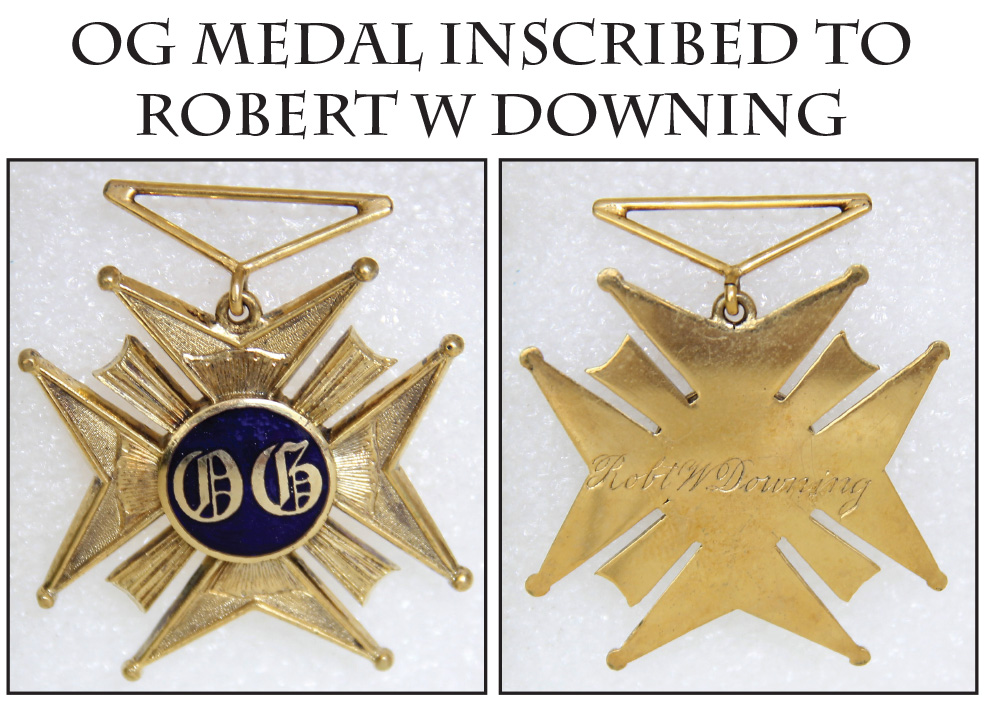
15-01-13 … Old Guard Medal Inscribed to Robert W. Downing …
Triangular ribbon bar at top from which is suspended a gilt brass cross with rays and a central roundel with deep blue enamel and gilt old English initials “O.G.” The “Old Guard” was a New York city battalion of the state National Guard formed in 1868 by the joining of two old militia companies: the New York Light Guard and the New York City Guard, each of them with long NY militia histories, and with service in the Civil War in the 9th and the 71st NYSM. I find two Robert Downings in the New York Civil War records, but neither seems a good candidate for our man and he is likely a postwar member of a very high-end New York National Guard organization, forming part of the guard and escort for governors and mayors at inaugurations, etc. An attractive 130+ year old US medal
… $125.00 – SOLD
Click Here to E-mail Us!
Call us @ 419-842-1863
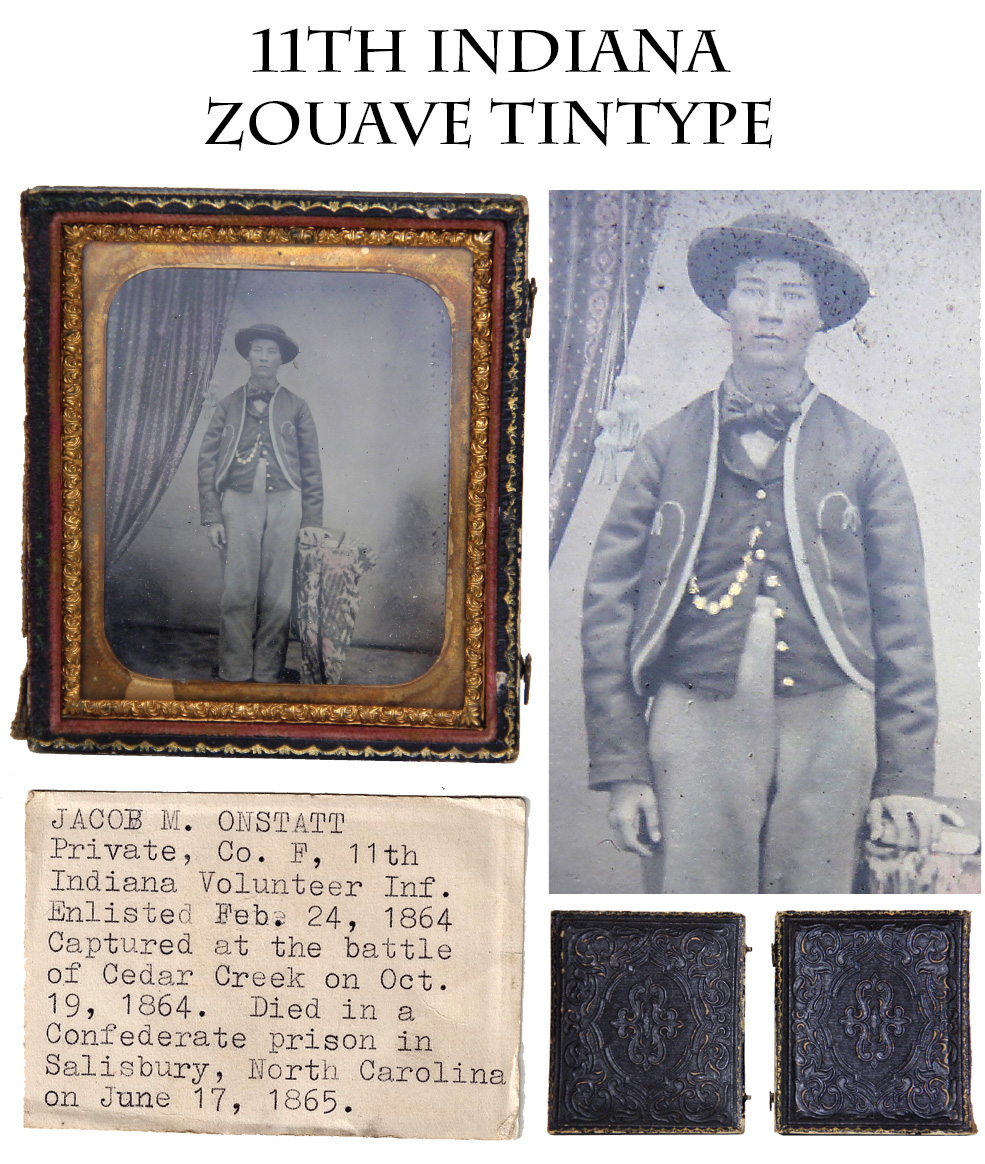
15-01-14 … A Wallace’s Zouave …
Several regiments in the Department of the Gulf adopted semi-zouave jackets like the one our fellow wears in this tintype but this is the exact pattern shown in a photograph published by Mike McAfee in Zouaves: The First and the Bravest on page 102 of a private in the 11th Indiana, Wallace’s Zouaves. Our fellow is shown standing, from the ankles-up, with his hand resting on a book on a small table. The buttons on his vest and his watch chain have been gilded, and there is delicate tinting to his cheeks. He wears a non-regulation brimmed hat. His jacket shows the leaf-ended tombeau and edge piping characteristic of this uniform. Accompanying the tintype is an old typed note identifying him as Jacob Onstatt of the 11th Indiana. A check of the records finds him listed as Jacob Onstott of Fulton County, Indiana. Records also show he mustered into Company F of the 11th Indiana in February 1864 and died as a Prisoner of War in Salisbury NC in January 1865. The 11th Indiana was originally organized for three months service by Lew Wallace, later General, politician and well-known author. Presented with a flag upon leaving for the war the regiment swore an oath on its knees to defend it to the death. The regiment saw service and some action in West Virginia before reorganizing for three years service in August, 1861. It served in the 13th, 19th and finally the 8th Corps. It fought and lost men at Fort Donelson, Shiloh, Port Gibson, Champion Hill, Vicksburg, Winchester, Fisher’s Hill and Cedar Creek, mustering out in July, 1865, having suffered 1 officer and 114 men killed in action or mortally wounded. They were a good, fighting regiment. Housed in a leatherette case, both halves present, but separated along the hinge
… $450.00 – SOLD
Click Here to E-mail Us!
Call us @ 419-842-1863
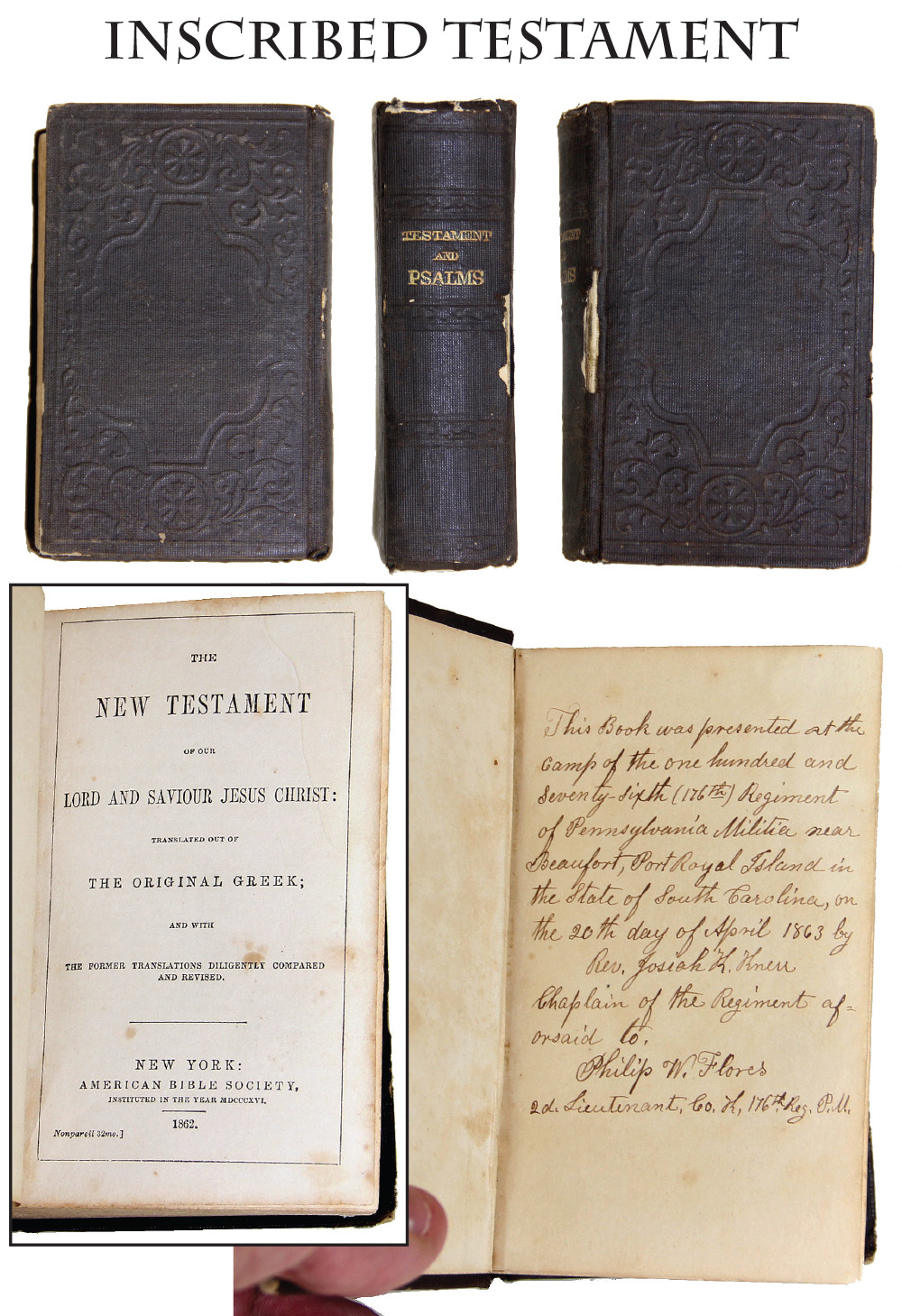
15-01-15 … Presentation New Testament From The Chaplain of the 176th Pennsylvania To One Of The Officers / Both Men From Allentown, Pa. …
Identified pocket Bibles and Testaments are neat personal items of Civil War soldiers. This one has a great inscription: “This book was presented at the camp of the one hundred and seventy-sixth (176th) Regiment of Pennsylvania Militia near Beaufort, Port Royal Island in the State of South Carolina, on the 20th day of April 1863 by Rev. Josiah K. Knerr Chaplain of the Regiment aforesaid to Philip W. Flores 2d Lieutenant, Co. K, 176th Reg. P.M.” (This is one of the better and lengthier inscriptions I have seen inside a Bible or Testament.) The 176th was a nine-month outfit, one of the regiments of “drafted militia,”, It was mustered in at Philadelphia in November, 1862, and served in the 7th Corps at Suffolk, Virginia. It then shipped out to the Department of North Carolina and Department of the South, where it served under Gen. Foster at New Berne and Charleston, doing guard and picket duty until muster out in August, 1863. Philip Wetzel Flores (1832-1908) enlisted 11/7/62 and mustered in the same day as First Sergeant of Co. K of the 176th PA. He was promoted Second Lieutenant on 12/6/62 and was mustered out 8/18/63. Flores may have known Chaplain Knerr previously, they both had an Allentown, PA., connection. After the war Flores worked for Internal Revenue, but was prominent in local history work, helping found the Lehigh County Historical Society. Josiah Knerr (1840-1917) must have been an interesting character: he enlisted as a common private and mustered into Co. B on 11/7/62, but was then promoted to regimental Chaplain 3/3/63 and served in that capacity until muster out in August. He was a member of the United Evangelical Church and is buried in Allentown, Pa. A very fine piece of Christian Military Ephemera with world class inscription and interesting history
… $325.00
Click Here to E-mail Us!
Call us @ 419-842-1863
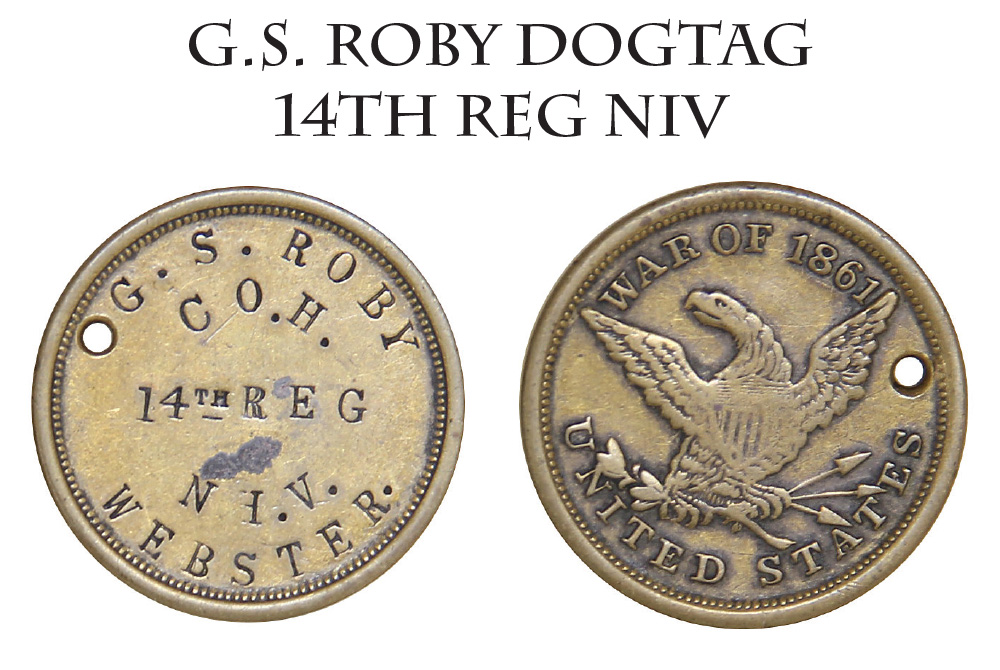
15-01-16 … 14th New Hampshire Identification Disc … Of some note to older collectors…
the grandfather of the late Civil War Collector and Author Francis Lord, served in the 14th New Hampshire. Lord wrote the various volumes of Civil War Collector’s Encyclopedias with the original first volume being a very good work. His grandfather may have been the source of Lord’s written text that the 14th NHV purchased many of these ID discs while passing through Charlestown, West Virginia, on their way to the Shenandoah Valley in 1864, from a sutler who had set up his tent beside the road. They probably acquired them on other occasions as well, but there’s a chance our man was in line next to Lord’s ancestor. Crisp example of the “Eagle/ War of 1861” pattern identification disc stamped for “G.S. Roby / Co. H / 14th REG / N.H.V. / Webster” These tags came in a number of patterns. All were private purchase by soldiers who may have liked wearing a medal, but also realized on a more practical level that they might well remain unrecognized if they fell on a battlefield. George S. Roby was born in Warner, NH, and lived there after the war, but was credited as a resident of Webster, NH, who enlisting at age 29 as a private on 8/14/62 and mustering into Co. H of the 14th NH on 9/24/62. He mustered out 7/8/65 at Savannah, GA.
The regiment served around Washington in the 22nd Corps during its early service and then shipped out for the Gulf in mid-1864, becoming part of the 19th Corps. When that corps returned north the regiment was for a time split, part serving with the Army of the James for a time. They were reunited in the Army of the Shenandoah and suffered their heaviest casualties at Opequan, 33 killed, and Cedar Creek, 7 killed.
The history of the regiment in the New Hampshire records has the following:
The charge of the Fourteenth-holding the right of the line- at the battle of the Opequan was a remarkable performance from any standpoint of criticism. Losing one third of its number in thirty minutes, the regiment advanced persistently until all semblance of formation was destroyed; and the scattered remnants retreated only on repeated orders. At Fisher’s Hill the advance was over the most perilous ground traversed by the Nineteenth Corps, and the steadiness of the Granite State boys was highly commended. At Cedar Creek, with the enemy on three sides, in the midst of indescribable confusion, the regiment fought on both sides of its breastworks, changed fronts while almost surrounded, and formed new lines at every command. Its signal steadfastness caused the brigadier to rally his shattered brigade on the colors of the Fourteenth New Hampshire.
A nice example of a key Civil War soldier’s personal item
… $795.00 – SOLD
Click Here to E-mail Us!
Call us @ 419-842-1863

15-01-17 … George Washington Pattern ID Disc For A Fighting Soldier In The 35th Mass. …
A scarce Washington pattern tag, made in brittania or pewter with handsome profile bust of Washington on the face with his name above and birth date below. On the other side in very attractive large, deeply stamped letters, with two flourishes marking off the middle section is stamped: W. H. Mathews / Co. C. /35 REG/ Mass. Vol.
William H. Matthews was a 24 year-old merchant from Chelsea when he enlisted on 7/17/62 as a sergeant and mustered into Co. C of the 35th Mass on 8/18/62. He died of disease 2/7/63. The regiment served in the 9th Army Corps. Matthews’s service was brief, but during his time in the unit the regiment saw some terrible fighting. At South Mountain they lost 2 killed and 14 wounded, at Antietam they lost 214 men, of whom an astounding 69 were killed or mortally wounded, and at Fredericksburg another 7 killed and 47 wounded. The 35th Mass had certainly “seen the elephant” while Matthews was in the ranks. A scarce pattern disc from a hard-to-find, hard fighting regiment
… $895.00 – SOLD
Click Here to E-mail Us!
Call us @ 419-842-1863
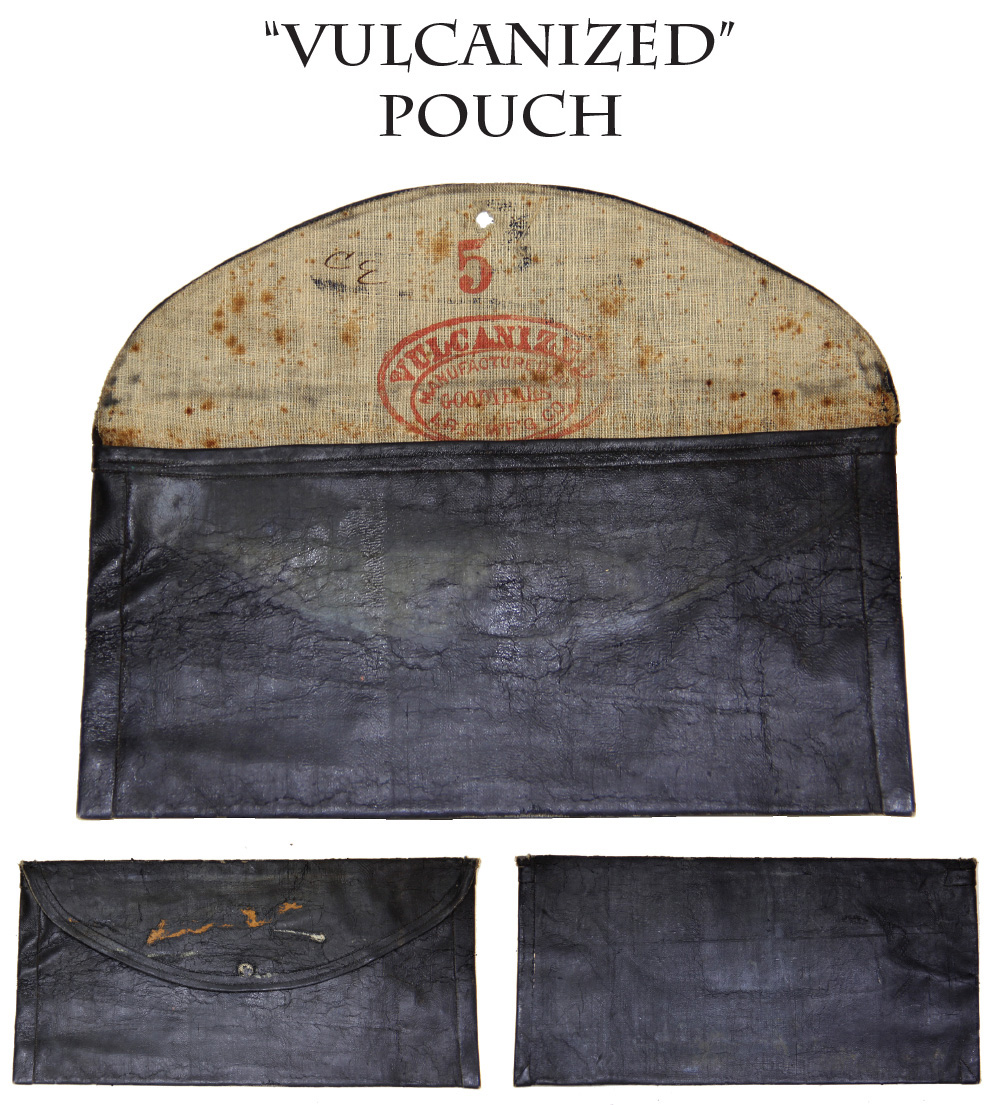
15-01-18 … Rubberized Wallet, Document Or “Possibles” Pouch:
Civil War rubber items are extremely rare. This is a superb condition vulcanized rubber pouch measuring about 8 inches long. It is well made and well marked on the inside of the flap in large red/orange letters: Vulcanized/ Manufactured by/ Goodyear’s / I.R.C. Mfg. Co.” along with a number “5” that may be the size or catalog number. Once Goodyear figured out how to make a rubber coating stable, all sorts of rubberized goods hit the market. Ponchos and gum blankets were the big military rubber items of the 1860s, but buying one of those things now requires a collector of modest means to secure a second mortgage, or rent out his children or grandchildren as day laborers. Other CW items such as this wallet are equally rare but far more affordable. Here’s a waterproof pouch that could keep money, documents, paper, etc. safe, or it could have secured items that might have leaked or spilled in a haversack or knapsack. I think it is a wallet. This has most of its rubber coating intact and just lacks the small fastening button. The marking is about identical to those found on military gum blankets. A truly RARE personal item, this is the first one I have EVER owned
… $450.00 – SOLD
Click Here to E-mail Us!
Call us @ 419-842-1863
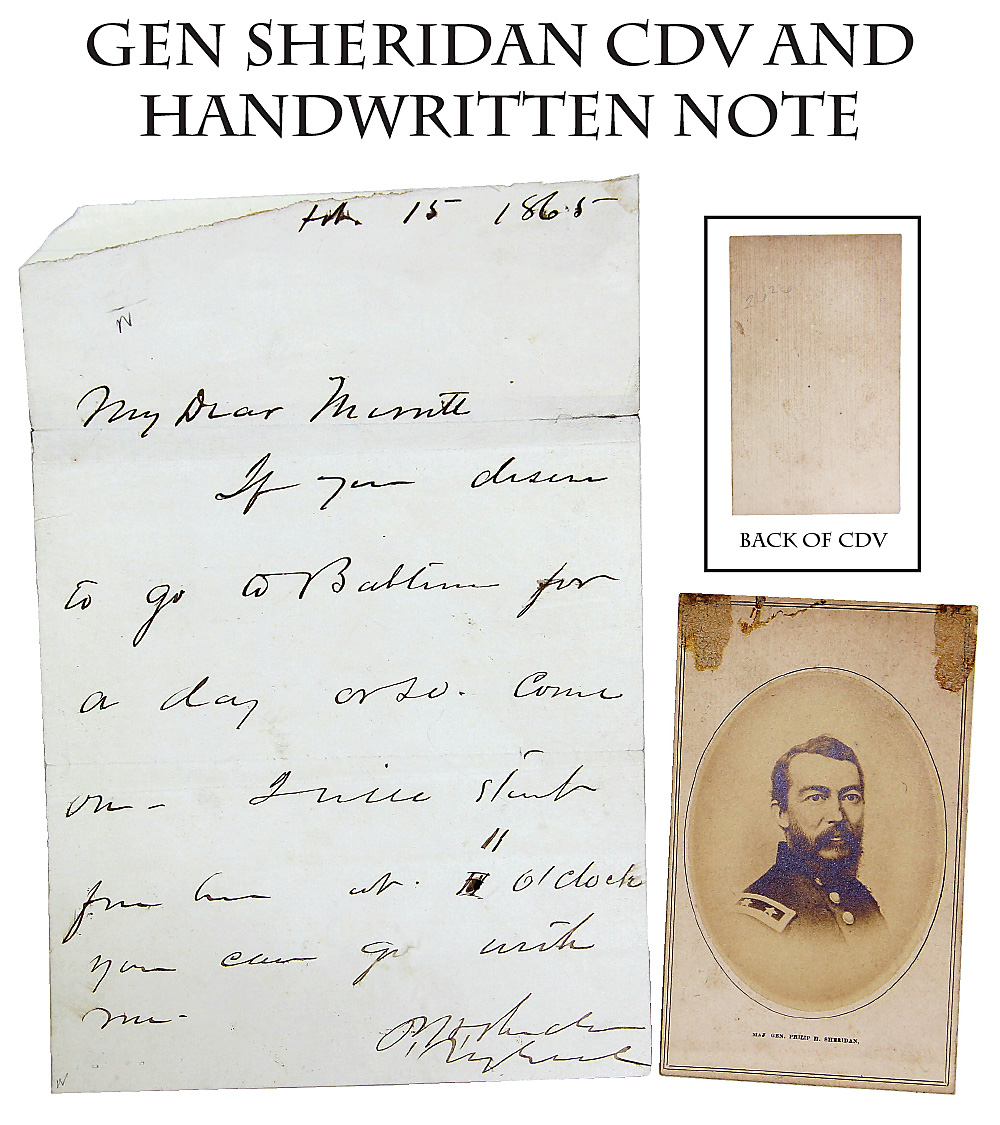
15-01-19 … War Date Handwritten Phil Sheridan Note To Gen. Wesley Merritt With Portrait CDV:
Original handwritten and autographed note by Phil Sheridan, noted general in the west and cavalry commander in the east. Addressed to “My Dear Merritt,” :
Feb 15 1865
My Dear Merritt
If you desire to to to Baltimore for a day or so. Come on.
I will start from here at 11 O’Clock. You can go with me.
P.H. Sheridan
Mjr Genl
Short yes, and a small top left corner is clipped, but it is a war date ANS sent to the renowned cavalry general Wesley Merritt… Custer’s peer. I am trying to picture Sheridan and Merritt as chums or pards, on the town in old Baltimore. Maybe there is a newspaper story about it somewhere. With this we include a period commercial CDV portrait of Sheridan with a printed name caption beneath. No backmark, as is common with these “pirate” images, copied by various photographers from copyrighted images and sold sold to the public during the war for placement in their own photo albums. A nice pairing for display or framing
… $575.00 – SOLD
Click Here to E-mail Us!
Call us @ 419-842-1863

15-01-20 … General Banjamin Butler Endorsement On Document From Headquarters Army Of The James And A CDV Portrait …
A nice example of General Benjamin Butler’s signature on a document making its way through the army bureaucracy. Several endorsements and two dated stamps showing a requested report or statement had made its way to the Provost Marshal’s Marshal’s office at Fortress Monroe on 11/19/64 and then been sent to Butler’s headquarters, where he read and forwarded it on 11/20/64 to Brigadier General Patrick “Provost Marshal Genl. armies operating against Richmond.” With this we include a Brady/Anthony seated view of Butler in civilian clothes from Brady’s National Portrait Gallery series. Butler was a successful politician and foolish general, “as visionary as an opium eater in council, as helpless as a child on the battlefield.” He got the nickname “Spoons Butler” in New Orleans from accusations he stole silverware during the occupation of the city, which is kind of ironic since this document is making its way to the army’s provost marshal- the head of the army’s police. These will look great when framed and matted on your collection room wall
… $295.00 – SOLD
Click Here to E-mail Us!
Call us @ 419-842-1863

15-01-21 … Pair of CDV Photos – Ellsworth And His Avenger: Francis Brownell:
Ellsworth was a friend of Lincoln’s and gained notice before the war by participating in the Zouave craze and taking his “Zouave Cadets” on a multi-city tour of drill competitions. When war broke out he became Colonel of the 11th New York, the “Fire Zouaves” recruited from daring men of city fire companies, and led them onto Virginia soil in the occupation of Alexandria. A local hotel keeper did not like him tearing down a secession flag on the roof of his establishment and expressed his dissatisfaction by blowing a hole through Ellsworth with a shotgun. Brownell was present and on the stairs with Ellsworth at the time, and settled accounts by bayoneting the inn-keeper to death “on the spot”. Both sides ended up with new martyrs. Ellsworth is shown in a Brady view in a dapper pose, his overcoat thrown back, hand in pocket, walking stick posed, and a military cap on his head. Brownell is posed in his fire-zouave uniform in a view published by Case and Getchell of Boston, one foot resting on a captured Confederate flag. Brownell has a period pen id at bottom front and is a tad light. Ellsworth has nice tones. Both have tax stamps. A collector mounted them side by side on an original double album page for display. The lettering at the top of the page is collector applied using good graphics. Ellsworth was famous enough that prints and paintings of his demise were popular, even water pitchers were marketed showing his fatal encounter. The pair
… $395.00 – SOLD
Click Here to E-mail Us!
Call us @ 419-842-1863
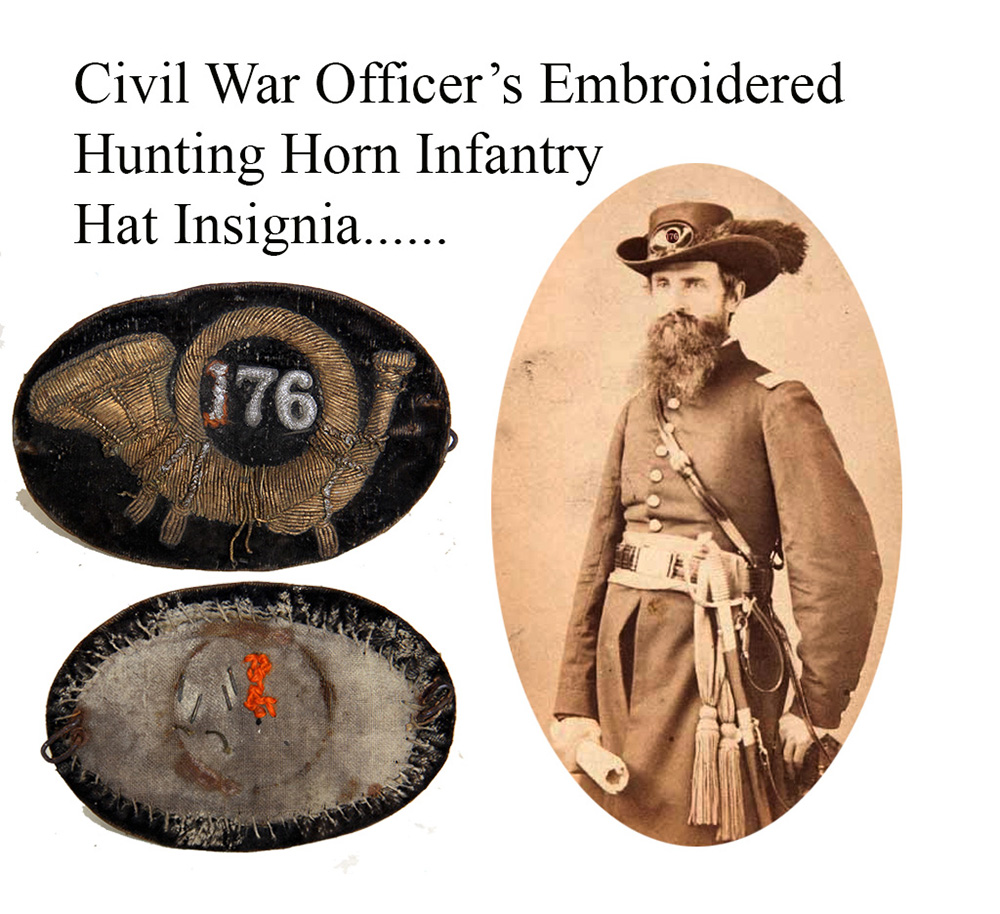
15-01-22 … Civil WAr officer’s Embroidered Insignia For The 176th Infantry …
There is no state affiliation for this regulation hat badge, but the high number limits it to New York, Ohio, or Pennsylvania. In any case, it is a nice large example of the regulation insignia for regimental officers of infantry: a heavy embroidered hunting horn in gold bullion thread with the regiment indicated by separately applied “false embroidered” metal numbers in the loop. Measures 3.5 inches wide and 2.25 tall. Both fastening loops are present on the back, and bent to the side. The bullion has good color with just some gray showing on a few of the bugle cord tassels and a couple of loose threads. There was likely a jacqueron wire border, but these are frequently missing from insignia that actually saw use and does not detract. There is a small bit of working of reddish orange thread from the reverse that partly borders the numeral “1.” Whether this was a repair of some sort or the officer started to outline the regimental numerals I can’t tell. Either way it’s a nice personal touch and the insignia would make a great addition to an officer’s display: In the clip-art shown at right I inserted the 176 into that officer’s bugle using computer magic. The insignia on his hat is about identical in size
… $465.00 – SOLD
Click Here to E-mail Us!
Call us @ 419-842-1863
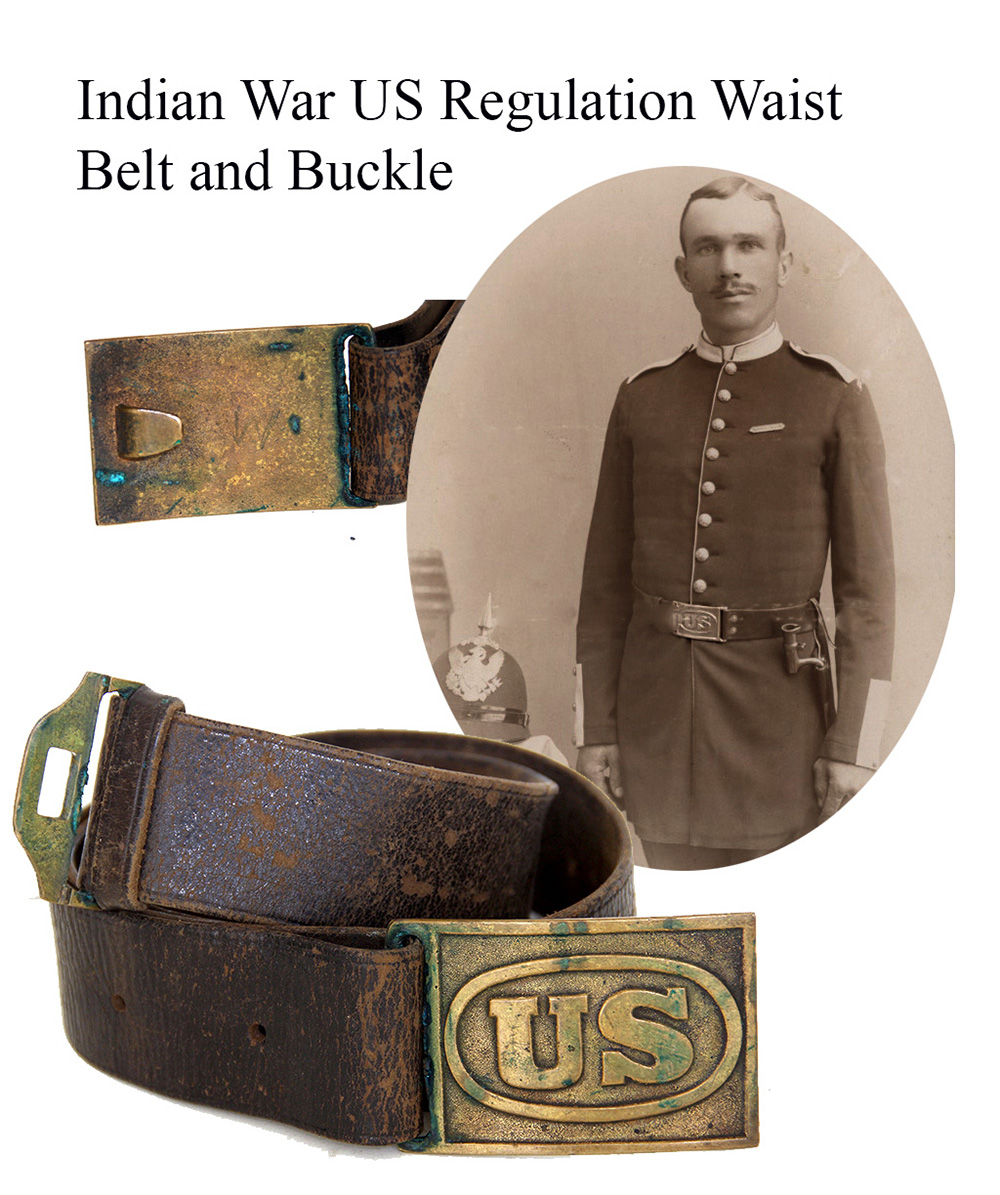
15-01-23 … 1874 Pattern Regulation US Army Waist Belt …
These rectangular US plates and belts often get sold as Civil War to the uneducated, largely because they were worn in innumerable old Hollywood Civil War movies from the early 20th century. They are in fact 1874 pattern belts. Here’s a nice example offered for what it is: the regulation US Army waist belt of the Indian Wars. The buckle first came in during 1872 with special fittings for the Palmer brace system, but was soon simplified and issued widely as you see it here. This one is uncleaned and un-messed with. Just like we want to find them and priced easy on the pocket book. A good Custer period US military belt
… $225.00 – SOLD
Click Here to E-mail Us!
Call us @ 419-842-1863
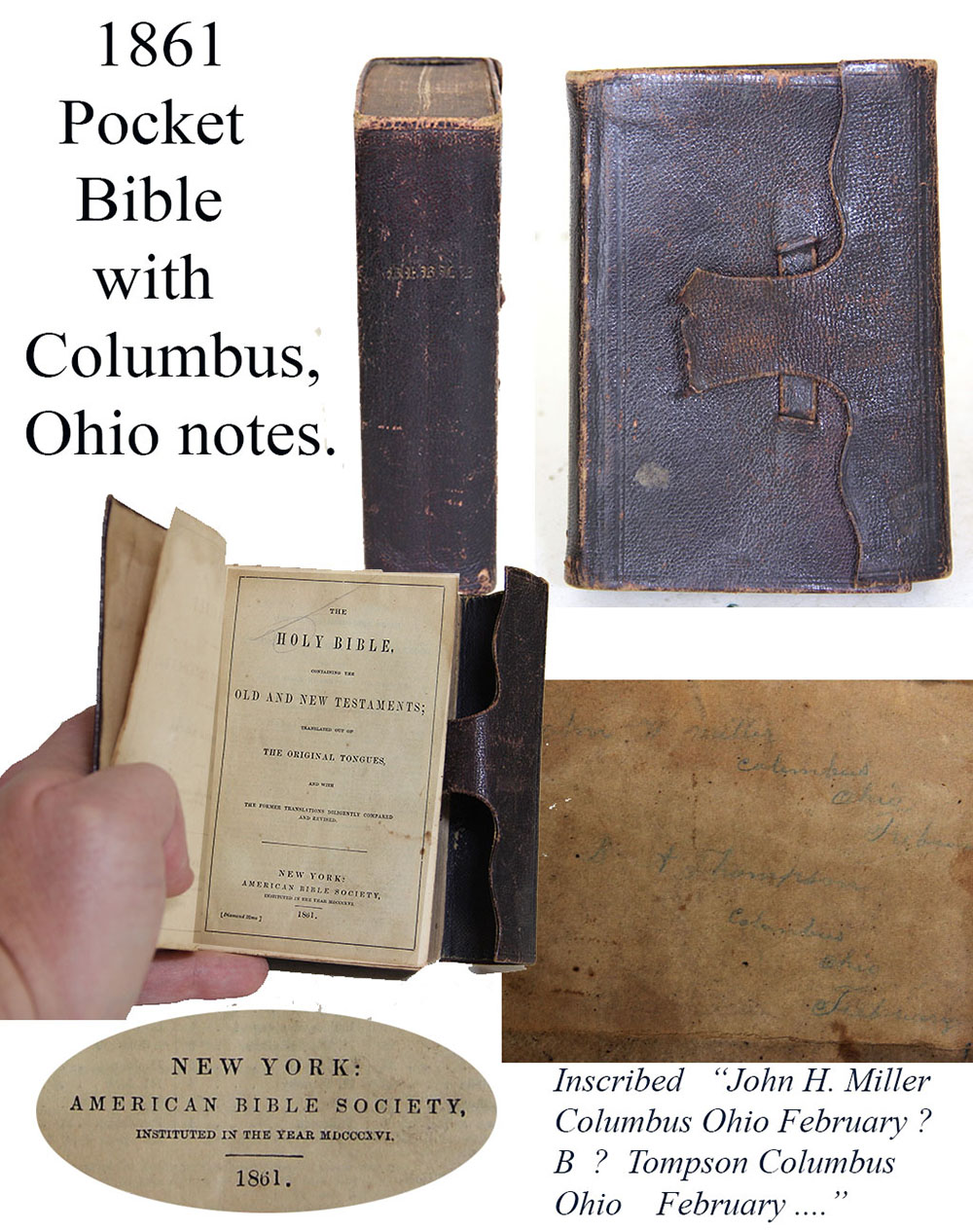
15-01-24 … 1861 Dated Pocket Bible With Ohio Inscriptions …
War date pocket bible published by the American Bible Society. Hundreds of volunteers received these from friends, relatives, the Christian Commission, and others. They are a key piece in a display of soldier’s effects, whether it saved his life by stopping a bullet or not. This one has a perfect war date and bears two men’s names inscribed on the back flyleaf, both are from Columbus, Ohio, and both date their inscriptions “February” with a year that I think is 1864. The top name seems to be John H. or John W. Miller and the bottom name B.A. Thompson. Some cross referencing of the names and units out of the Columbus area might provide an identification, but I leave that to the buyer
… $95.00 – SOLD
Click Here to E-mail Us!
Call us @ 419-842-1863
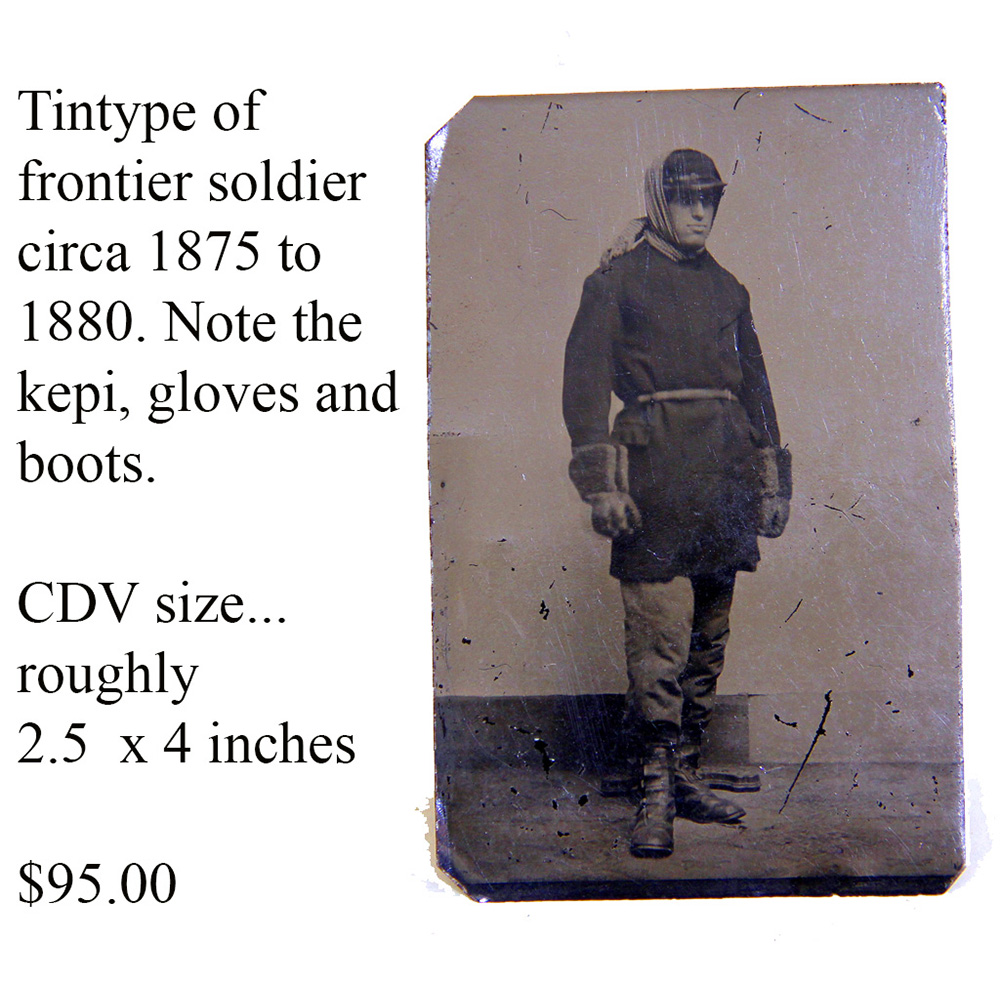
15-01-25 … Rigged Out For Cold Weather!
… This soldier looks a bit like helper Tom when I send him out to shovel the drive here at the shop: sturdy boots, big fur guantlets, a parka securely belted at the waist to keep out the cold and scarf at the throat and looped over his head to keep his cap on. But Tom isn’t nearly as sturdy looking as this guy. The chinstrap and buckle of the kepi are just visible. He’s a classic Indian Wars soldier ready for a cold day on the frontier. He is one dapper dude ready for work, shown in a tintype trimmed to CDV size for album insertion or use in a paper mount … roughly 2.5″ x 4″
… $95.00 – SOLD
Click Here to E-mail Us!
Call us @ 419-842-1863
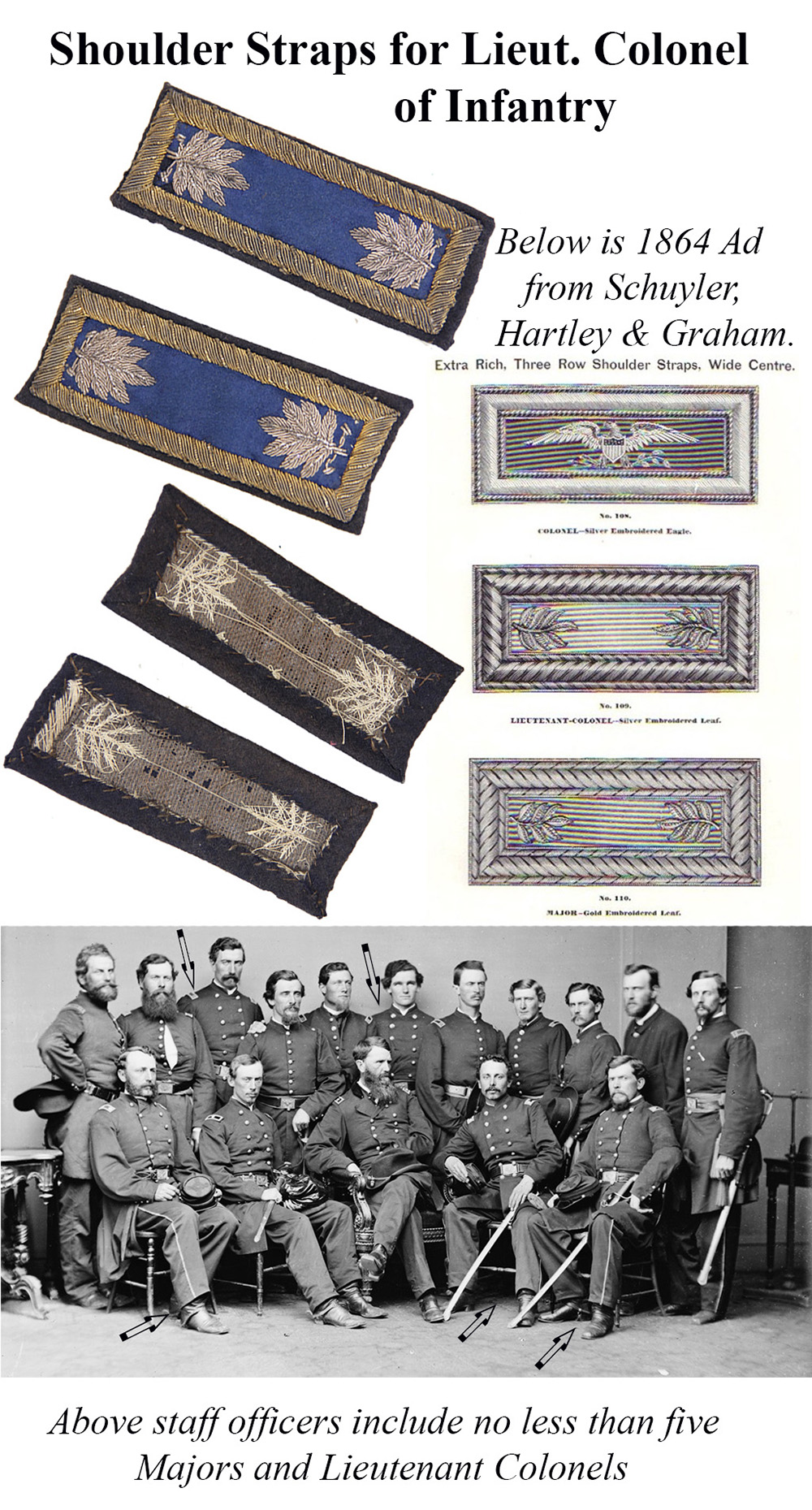
15-01-26 … Shoulder Straps For Lieutenant Colonel Of infantry …
Excellent condition set of shoulder straps for an infantry Lt. Col. Measuring 4 by 1.5 inches. Given that there were thirty line officers and only three field grade officers in an infantry regiment, any insignia for a field officer is ten times rarer than its equivalent in lesser ranks. Distinguished on the field by their double-breasted uniforms and the fact they were mounted, Majors, Lt. Colonels and Colonels of infantry were real front-line combat officers with significant casualty rates. Our straps are a standard single-bordered set with characteristic “dead and bright” gold bullion borders and silver bullion oak leaves at each end. These are true infantry straps with the lighter blue centers (background material) as opposed to the more common staff straps with dark blue or black centers (background material). These are constructed with the typical unfinished back, which is correct and proper on Civil War straps… exactly what you want to see. Insignia collectors look for all the variations of rank and service, single-bordered, double-bordered, triple-bordered, Large, Small, etc. These are the most typical of what an officer would wear in the field: nothing too elaborate to call attention from an enemy sharpshooter, but fully following regulations for displaying rank in combat. Just a few minor moth nips to the web backing, the wool face and bullion embroidery are pristine, with great color
… $650.00 – SOLD
Click Here to E-mail Us!
Call us @ 419-842-1863
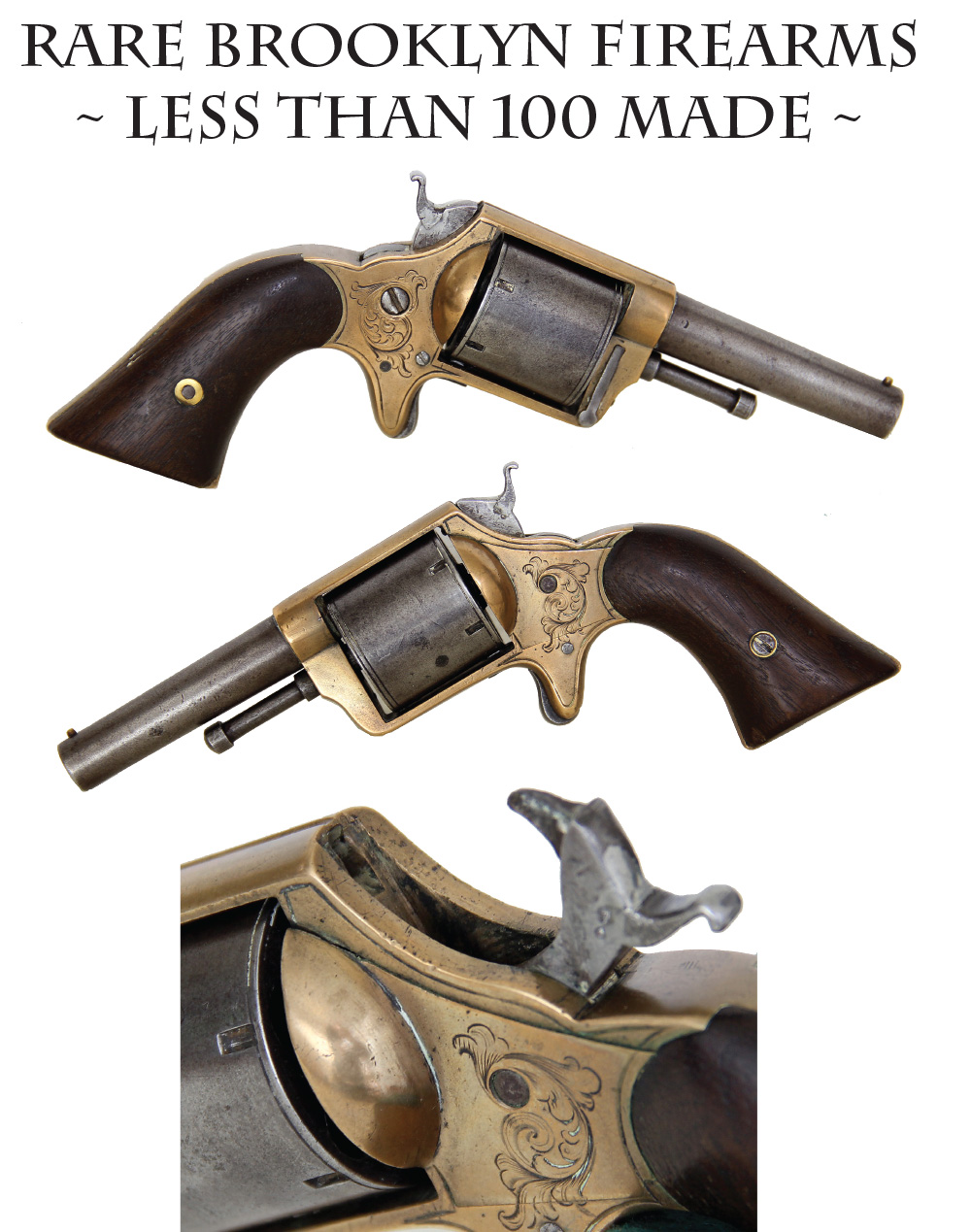
15-01-27 … Brooklyn Arms Company Straight Cylinder Pocket Revolver …
Made by the same company as the Slocum sliding chamber revolver we offer above, this is a more standard six-shot .32 rimfire pocket revolver that uses the same style brass frame with spur trigger and decorative floral scroll engraving. Nice wood grips, three-inch barrel. Completely unmarked, which is proper, since this pattern clearly infringed on the patent to the Rollin White cylinder owned by Smith and Wesson. This probably also explains why the gun is so darned rare: Flayderman estimates that fewer than one hundred were made! Ours has a nice mellow tone to the brass, a good fit of the grips to the frame and a clean barrel, cylinder and pin, just some faint plum brown showing through the dull silver. Mechanically functional. This is a nice looking pocket pistol, a good civilian or officer’s sidearm, and a very, very scarce piece in the history of US firearms development
… $975.00 – SOLD
Click Here to E-mail Us!
Call us @ 419-842-1863

15-01-28 … CDV of 5 black children …
Very nicely posed shot of five young children posed on a floral mat covered seat with the three smallest in front and the elder boys at rear. Tuttle, Belfast, Maine backmark. A very crisp card with good clarity and tones, and a scarce subject. About as striking a piece of African-American 1860s photo history as I have seen lately. xcjjx
… $495.00 – SOLD
Click Here to E-mail Us!
Call us @ 419-842-1863
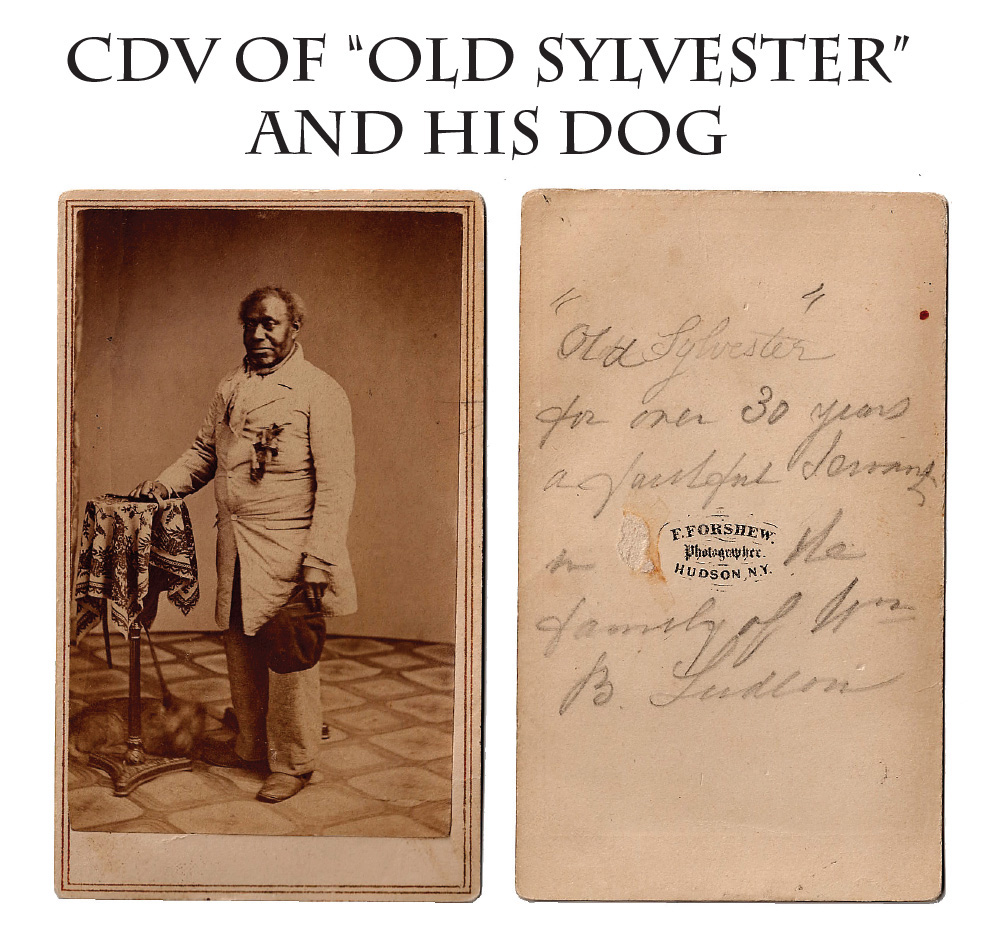
15-01-29 … CDV of “Old Sylvester” and his dog …
Forshew, Hudson, NY, backmarked CDV of an elderly black gentleman standing next to a draped stand, holding his hat in one hand and the leash of his dog, who is lying beneath the stand next to him. Period pencil identification on reverse: “Old Sylvester” for over 30 years a faithful servant to the family of Wm. B. Ludlow.” This almost certainly refers to William Broughton Ludlow (1788-1865) a prominent land owner in Claverack, NY. The family house is now on the National Register of historic places. An very interesting shot of very under-represented part of American 19th century society to say the least! xcjjx
… $475.00 – SOLD
Click Here to E-mail Us!
Call us @ 419-842-1863

15-01-30 … Recently Freed Slaves From New Orleans …
Wonderful 1863 era carte-de-visite by Kimball of New York showing three Louisiana slaves freed by the occupation of New Orleans in 1862. A copyright is printed at the bottom front and the reverse bears the statement that the “net proceeds” from the sale of the photograph would go to the education of colored people in the Department of the Gulf, “now under the command of Maj.-Gen. Banks.” A young boy and girl in front, an older woman apparently standing on a concealed ledge to give a better composition. Slightly trimmed top and bottom, not affecting the image or copyright. Very good condition, superb clarity and tones. A telling image. Great faces showing a hard life and an uncertain future. The dark complected lady shows a mystery of emotions on her face. Strength, pain, resolve, anger, resentment … It’s darn hard to translate everything in that face. We can only imagine
… $950 – SOLD
Click Here to E-mail Us!
Call us @ 419-842-1863
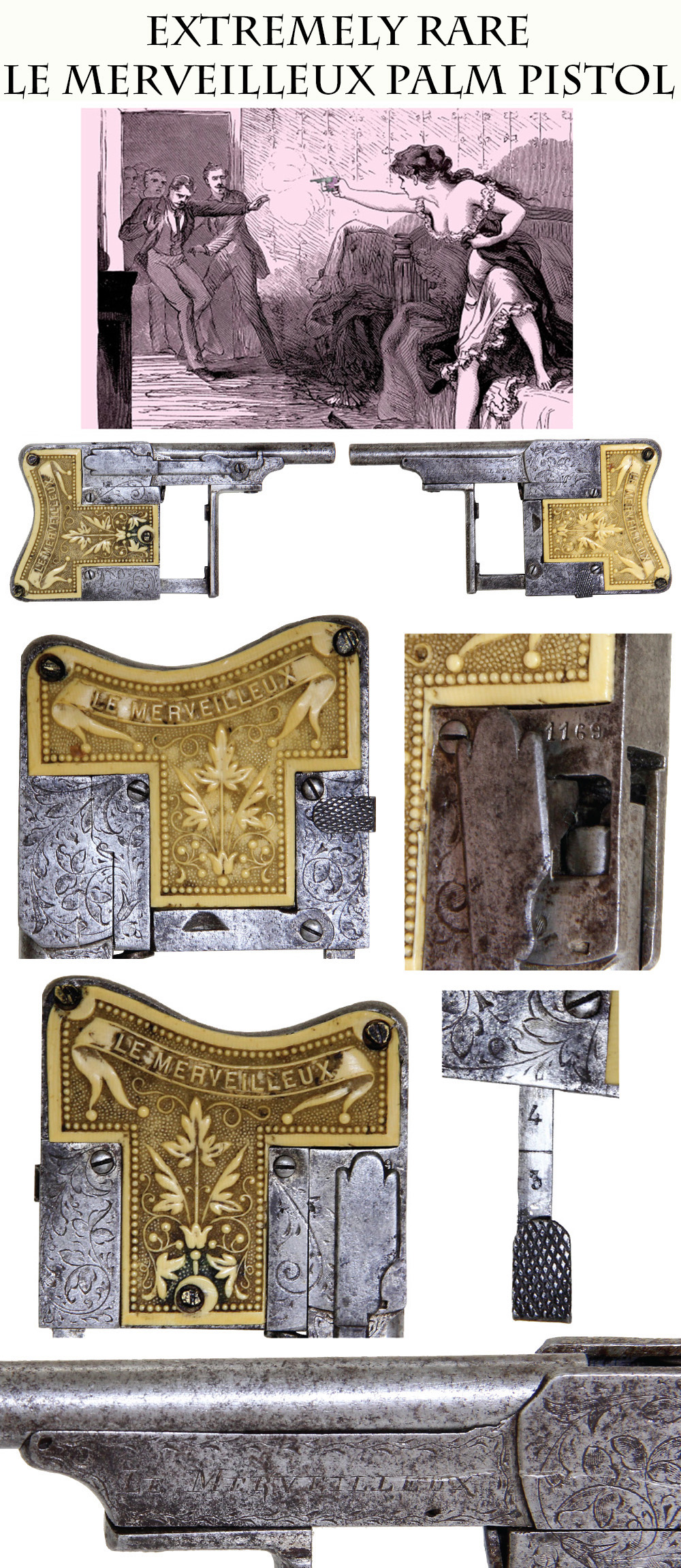
15-01-31 …
Exceedingly Rare Deluxe Grade Le Merveilleux “Squeeze Fire” Palm Pistol! …
These 1880 era diminutive French 6mm pocket pistols are functional small works of art, and a true curiosa. They were made in common grades with hard rubber grips and in deluxe grades using top end materials like this one … executed in the finest and most desirable carved “bone”. The barrel is a mere 2 ¾ inches, round and unmarked. The frame is hand engraved overall with floral motifs and is inlet on either side for T-shaped flat factory relief carved grip panels that are relief carved on a raised dot background with the pistol name (Le Merveilleux = “The Marvel” or the “The Wonder”) in a thin banner across the back edge with a blossoming plant beneath, framed with raised dots. No doubt buyers of the gun would “marvel” at the tiny size and incredible beauty, just the way we collectors do 130 years later. Truly a fascinating antique gun. The metal is smooth gun metal grey and the grip panels are extremely nice, no chipping and a pleasing mellow patina with just enough dirt in some of the crevasses to enhance and highlight the antique patina. The pistol is small enough to fit in the palm of the hand and is fired by squeezing the front part of the grip, which acts as the trigger. It is all original and complete as far as I can see. This one functions up to the point of actually “firing”. When the trigger bar is pulled back the action functions but the firing pin does not fire. I do not know if this gun requires a cartridge to accomplish that function or if there is a tune-up required. In any event the gun cannot be fired as there are no 6mm black powder cartridges available … making the question near moot. On the other hand… if you are a handyman you might like to figure out the mechanics where I cannot. I like just looking at it in the display case. Significant markings in addition to the artistic engraving includes a serial number behind the loading flap, two other numbers that may be assembly numbers on a pull slide on the bottom left of the handle, and the pistol name engraved in the metal receiver just under the barrel. Just the thing for a night out at the opera, Folies Bergere, or the Absinthe bar. A
refinished
example sold April 30th 2010 for $3,585.00 at Rock Island Auction. Again,
sold
for $3,585.00 as a
refinished
gun! I wager you will not see another for sale this year, especially priced this friendly. We offered this at $2450 a few weeks ago, and to my great surprise it did not sell. I will price it insanely low here on our first list of 2015 … and if it doesn’t sell this time I’ll send it to auction
… $1,650.00
– SOLD
Click Here to E-mail Us!
Call us @ 419-842-1863

15-01-32 … Untouched Civil War Ames 1840 Pattern Light Artillery Saber …
Regulation 1840 pattern saber for light artillerymen. These were meant as last resort weapons for the mounted drivers and NCOs in a light artillery battery. They show up in two types: one where the scabbard lacks a throat and seats in a recess on the underside of the guard, and another like this one, with the more conventional scabbard throat and sealing pad at the blade shoulder. Ours is clearly marked and dated: Made by Ames Mfg. Co. Chicopee, Mass. and US/ ADK/ 1865 on either side of the ricasso. Blade is VG and shows bright areas under light and dark gray sections. It might brighen up a bit with a careful cleaning. Like the blade, the scabbard and hilt are untouched. The scabbard showing faded bright finish now as a dull silver mixed with gray areas, no dents or dings. The hilt is likewise undisturbed: original twisted brass wire over original leather showing just honest wear and abrasion on the high spots, brass pommel and knuckle guard with a darkish mellow patina. It is hard to find one these days that has not been messed with. Straight out of the attic …
qe+eldrdg
… $795.00 … – SOLD
Click Here to E-mail Us!
Call us @ 419-842-1863

15-01-33 … US Model 1842 Springfield Musket …
The last of the .69 caliber U.S. muskets and the first of the percussion long arms for general issue to infantry, though still intended to spew out buck and ball rounds at the enemy. These are key pieces in US martial arms development. One innovation in the 1842 Pattern Percussion Musket was its use of fully interchangeable parts. Another was its production at both the Springfield and Harpers Ferry Armories. Here is an example with a Springfield 1848 dated lock and a Harpers Ferry Barrel. Overall VG condition. Most markings are clear. The eagle forward of the hammer is too light to make out, though the Springfield and 1848 date behind the hammer are sharp. The barrel has been gently cleaned to a light silvery gray and shows minute salt and peppering that is not obtrusive. There is deeper pitting at the muzzle forward of the nose band. Despite the cleaning the barrel shows clear V/P/eagle proofs at the left breach, and just forward of them the Harpers Ferry barrel proof of AR/P for Adam Ruhlman, who was inspecting barrels ca. 1850-52. Rod and swivels, all bands and front site and bayonet stud are in place, the hammer face shows a slight chip, as does the nipple, which sits a bit high and is certainly a replacement. The wood has mixed light brown and darker tones. No cartouches are visible, but a soldier or owner scratched a P into the butt stock and the side flat aft of the side plate. Edges show rounding from actually use, and the wood has numerous age dings as should be expected, but is solid, with no cracks or edge chipping. These guns saw a lot of use early in the Civil War in the hands of volunteers rushing to the battlefield on both sides …
hej
… $1,075.00
Click Here to E-mail Us!
Call us @ 419-842-1863
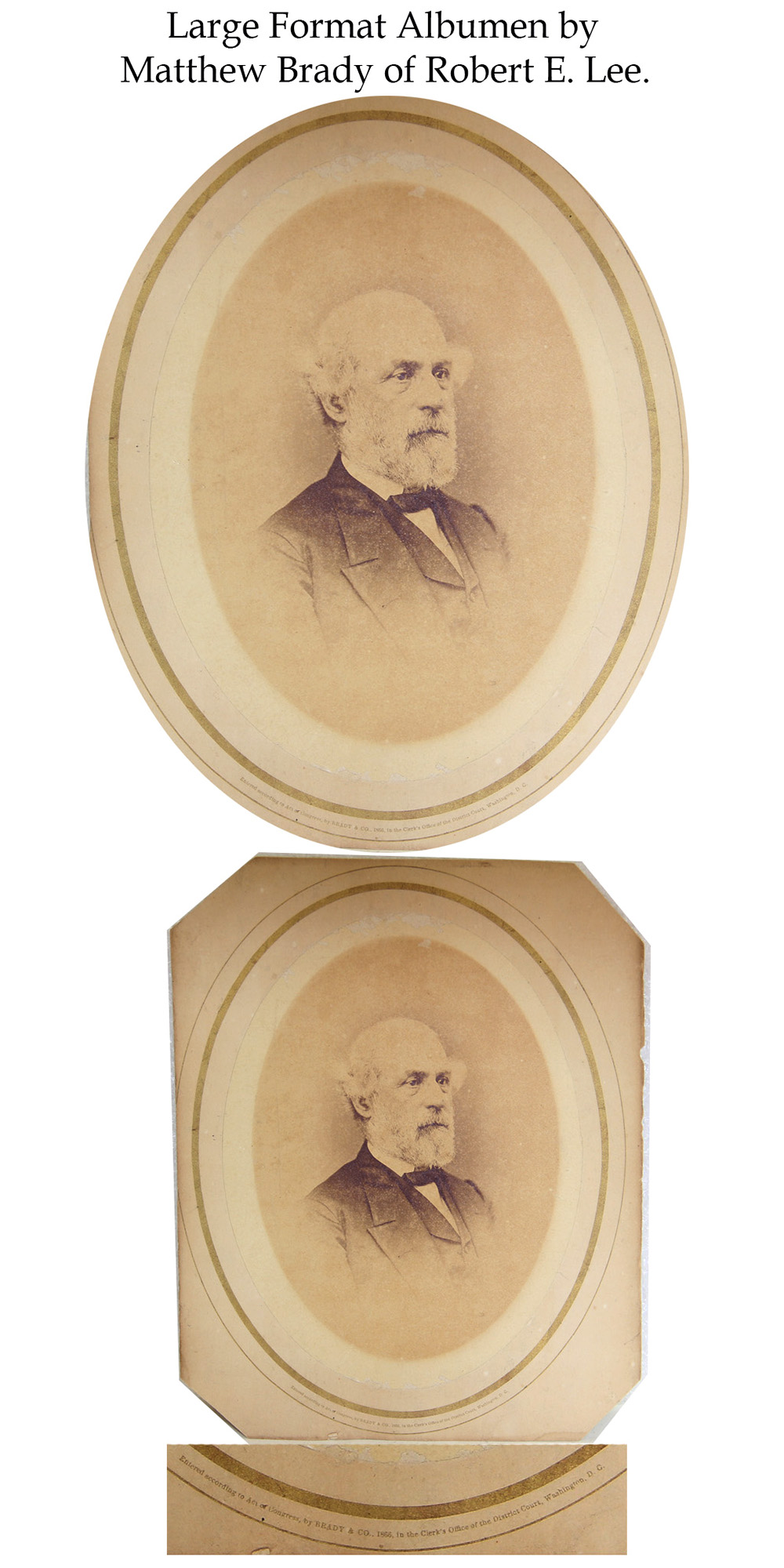
15-01-34 … Very Nice LARGE Albumen of Robert E. Lee by Matthew Brady Himself:
Very appealing “from-life” large oval vignette portrait of the most famous and most highly respected of all Confederates. Marse Robert himself. “The King of Spades”. This photo actually taken by Matthew Brady himself. A truly significant piece of antique photography. Mount measures roughly 8″ by 10″. Printed with thick and thin gilt borders between which is printed in the lower curve, Brady’s copyright information: “Entered according to Act of Congress, by Brady & Co. 1866, in the Clerk’s Office of the District Court, Washington, D.C.” Corners of the mount were clipped for framing in the period. Just the lightest foxing lines on the very edge of the card mount, a little roughness to the right edge and slight stain at bottom, but all this is only on the mount, coming nowhere near the image. Lee was a familiar customer of Brady’s: according to the latter they had known one another since the Mexican War, and some suggest a daguerreotype of Lee taken in New York City about 1845 was by Brady when new in the business. Fast forward twenty years … Just days after the surrender at Appomattox Brady used his personal connections with the family to get Lee and staff members to pose for him in Richmond in 1865. This 1866 dated pose was probably taken when Lee came to Washington in early 1866 to testify before a Congressional Committee on Reconstruction. Lee shows all his strength of character as he transitions into the new role of vanquished general and educational leader as a university head. A very rare image in this large 8 x 10 format. Shows only the lightest age and toning. I believe I have owned only 2 or 3 large size Lee albumens in 40+ years of collecting
… $1,650.00 – SOLD
Click Here to E-mail Us!
Call us @ 419-842-1863
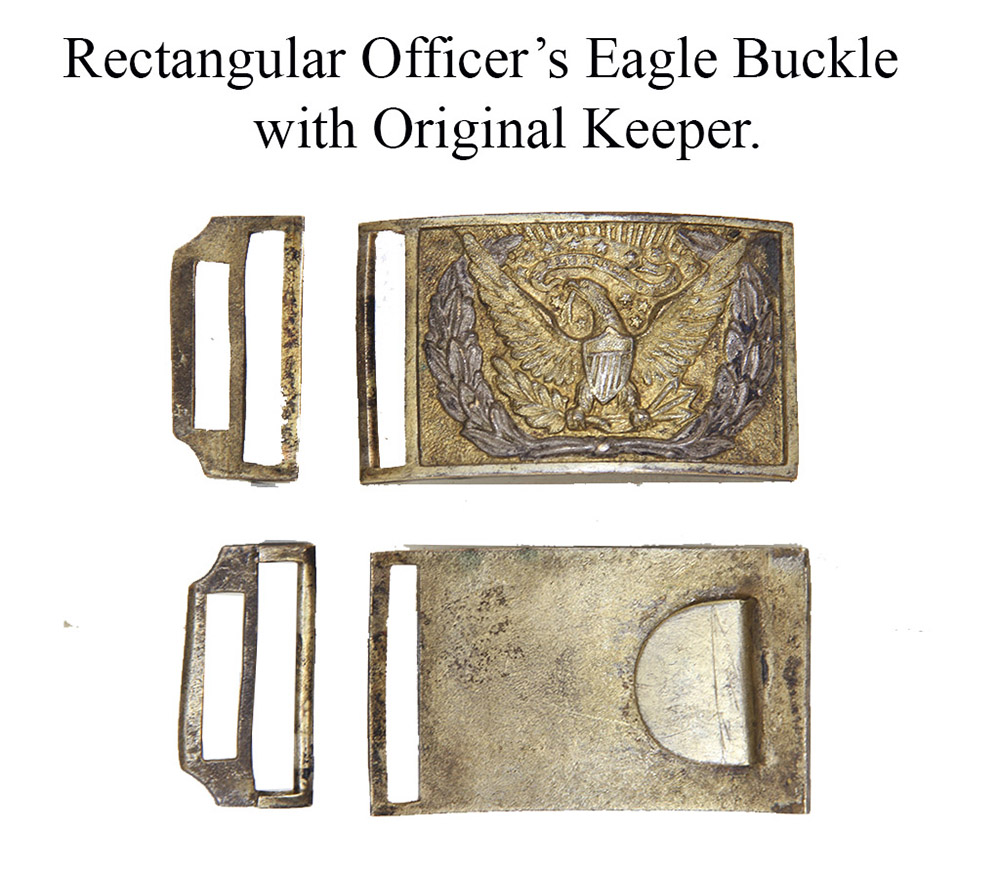
15-01-36 … Rectangular Eagle Sword Belt Plate:
Very solid buckle with the original matched keeper. Officer’s pattern with integrally cast wreath around the eagle. The wreath has been chased with silver plate. Mid to late war example with medium wide tongue. Much gilt on face. Back has some silver paint or silver plate? I was lucky and found it last week for 125 so I can sell it friendly
… $225.00 – SOLD
Click Here to E-mail Us!
Call us @ 419-842-1863
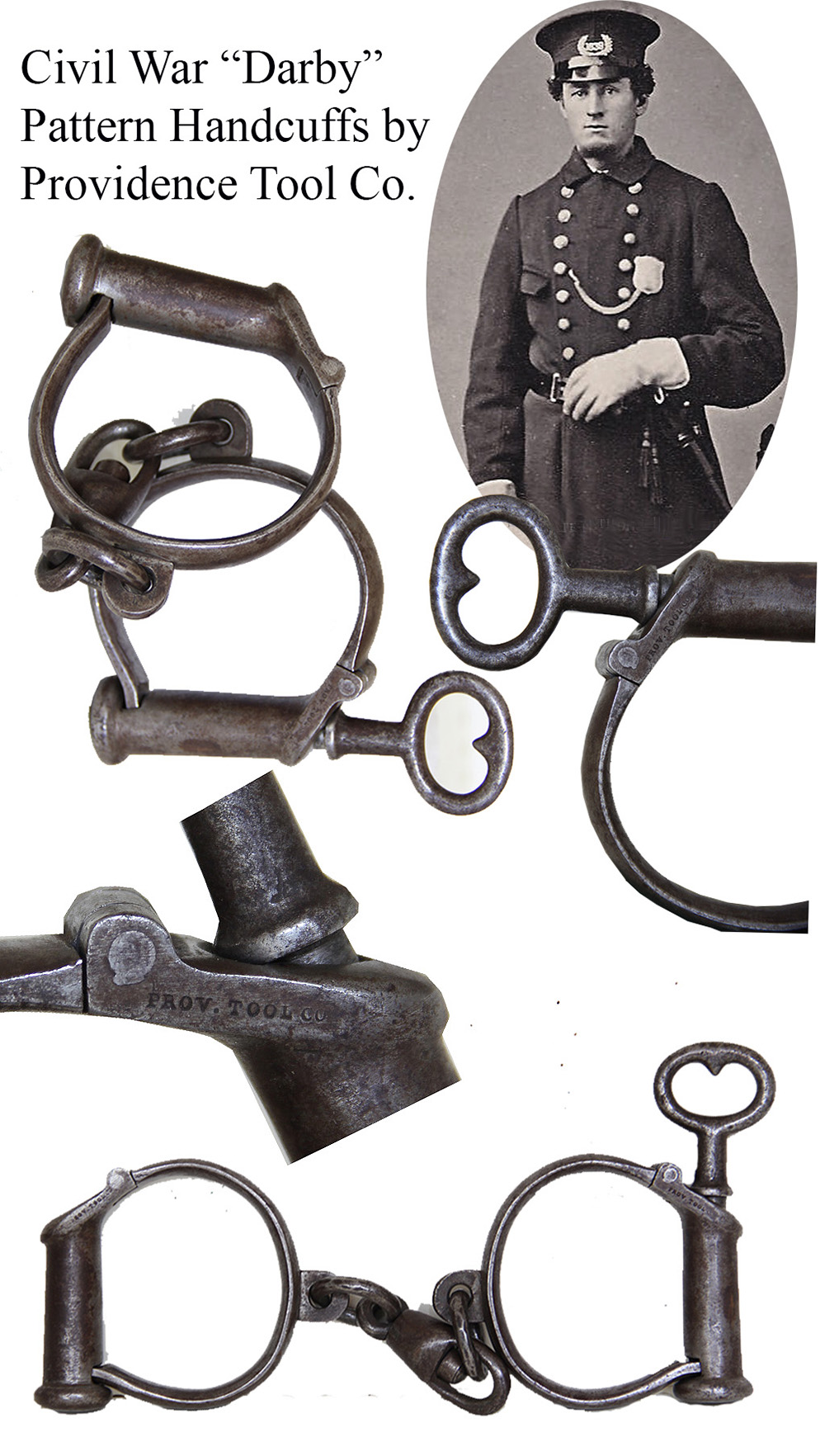
15-01-37 … Civil War Handcuffs:
Classic 1860s American handcuffs used by both military and civil services. These are the early Darby pattern cuffs, (originally designed in Britain), which began to fall out of favor as early as 1862. The Darby cuffs were not adjustable for size … hence a problem with smaller prisoners. According to Matthew Forte’s book American Police Equipment … two American patents were issued for this Darby style restraint. One in 1860 to William Kimball of Maine and one in 1862 to Alfred Delestatius of Philadelphia. Forte further cites most of these 1860s American cuffs are found signed “Providence Tool Co.” or “Thompson.” By 1862 adjustable cuffs were being patented and proved far superior in keeping prisoners restrained. The early Darby design became obsolete. Of peripheral interest … Harry Houdini used the obsolete Darby cuffs in his escape acts. He had figured out how to release the primitive locks through force without the need for a key. A search of the internet shows my good friends at the Horse Soldier Shop in Gettysburg sold a set of these for $595.00. I bought these “right” and will sell them for
… $450.00 – SOLD
Click Here to E-mail Us!
Call us @ 419-842-1863

15-01-38 … Springfield M1816 Conversion Musket:
Typical Early Civil War musket used by both North & South with soldier’s initial carved in the stock “B” or “D over D”, behind trigger guard tang. This is an 1816 pattern musket smooth-bore .69 caliber, with a correct arsenal conversion to percussion using the “cone-in-barrel” or “Belgian” method of conversion. This was done from 1848-57. Of some interest is the fact that guns dated after 1832 were considered first class and prime candidates to be updated. Nice overall untouched condition. Smooth metal with undisturbed age brown patina, nice wood with just a few dings. The original 1838 date of manufacture is clearly stamped at the rear of the lock plate, as is “Spring Field”” and their eagle at front. Barrel markings are obliterated under deep rust brown patina. The inspector’s view mark (cartouche) on the wood opposite the lock is plainly visible. Swivels in place, correct original rod, front sight on top band, bayonet stud in place near muzzle. Mechanically excellent, 100% original 100% complete. These are the guns that fought the Civil War for the first couple of years until imports, arsenals and contractors could get up to speed. This is about as honest an 1816 as you could hope to find and priced very realistically at
… $950.00 SOLD
Click Here to E-mail Us!
Call us @ 419-842-1863
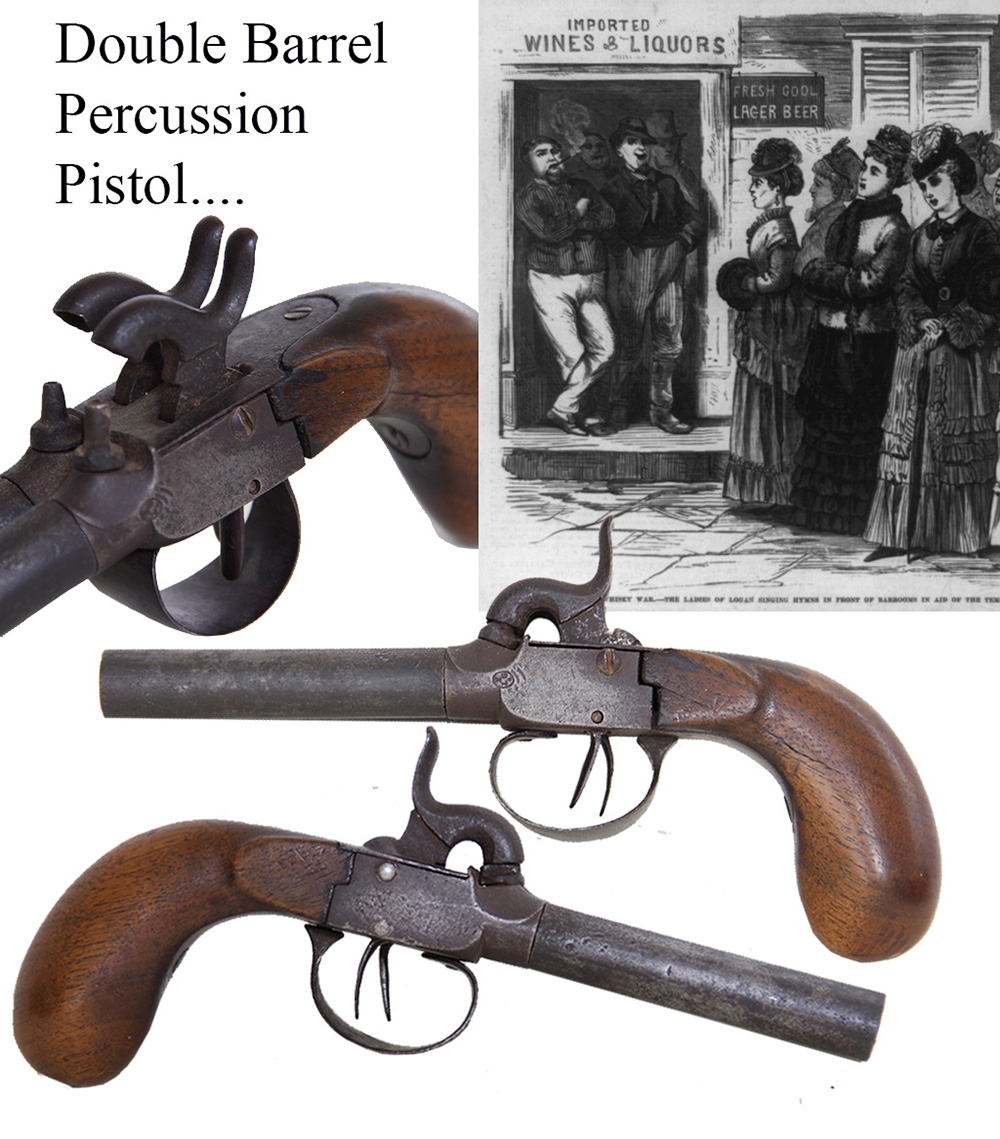
15-01-39 … Double Barrel .45 Caliber Percussion Pocket Pistol:
Two are better than one! 1850s-1860s era pocket pistol set up with two barrels, two hammers, and two triggers. Nothing complicated, just one more of everything in case the first shot goes awry or misfires in a tight situation. Barrels are three inches long and roughly .45 caliber. (That’s BIG BORE on a small gun like this!) Simple bag-shaped wood grip, tight to the metal on the right, a small gap on the left with a hairline crack running back about to inches, but stable. Small Liege stamp on the left frame below the nipple. Mottled gray and faded dull overall. An inexpensive alternative to revolving pocket pistols, but enough firepower to deter a street-ruffian if necessary. Some of these were supplied by well-meaning relatives to soldiers and many have been excavated in Civil War camps and on battlefields. They were often confiscated by officers to prevent mayhem in the barracks when the recruits first showed up with these “home style” weapons. Mechanically functional. Nipples not battered down. A good example of the type with rather elegantly curved hammer spurs
… $245.00 – SOLD
Click Here to E-mail Us!
Call us @ 419-842-1863

15-01-41 … Group of items belonging to Major Daniel Mead of the 10th Conn. Infantry …
Includes a circa 1855-57 1/6 plate, 2/3 length daguerreotype of Mead in a civilian suit with books on a table and one held open in his hand. Half case, brass mat and protector remain with the image. His Major infantry shoulder bars are also in the group. They are well worn and slightly soiled, with triple gold bullion borders. Oak leaves are also in gold bullion with blue wool centers.
Last, the crown jewel of this group … a fascinating journal kept by Mead in 1854 while a law student at Poughkeepsie, N.Y. Several interesting trips Mead takes are detailed. The book measures about 6.5″ x 8″. All writing is in ink. Most interesting is 15 pp of “The Catskill Mountains. A 30 mile trip on foot.” detailing this rugged area. Also 22 pp of a trip to “West Point on the Hudson” with a second visit detailed later in 8 pp. Lastly, 11 pp of “Sail to New London Onboard the William Chard.” Several lawschool lessons / lectures also given. In the back are a number of clipped autographs of Confederate and Union officers including A.B. Levissee of Talladega, Alabama CS Staff Officer and R.A. Turnipseed of South Carolina later Colonel of the 9th Georgia… Miles W. Hawley of Hornellsville NY who served in the 141st New York plus others …
Mead died of typhoid fever at Stanford, CT on September 19, 1862. The 10th was formed October 22, 1861 for 3 years of service and participated in Burnside’s ill-fated expedition early in 1862 and the Battle of New Berne … yabejzx
… $1,550.00
Click Here to E-mail Us!
Call us @ 419-842-1863
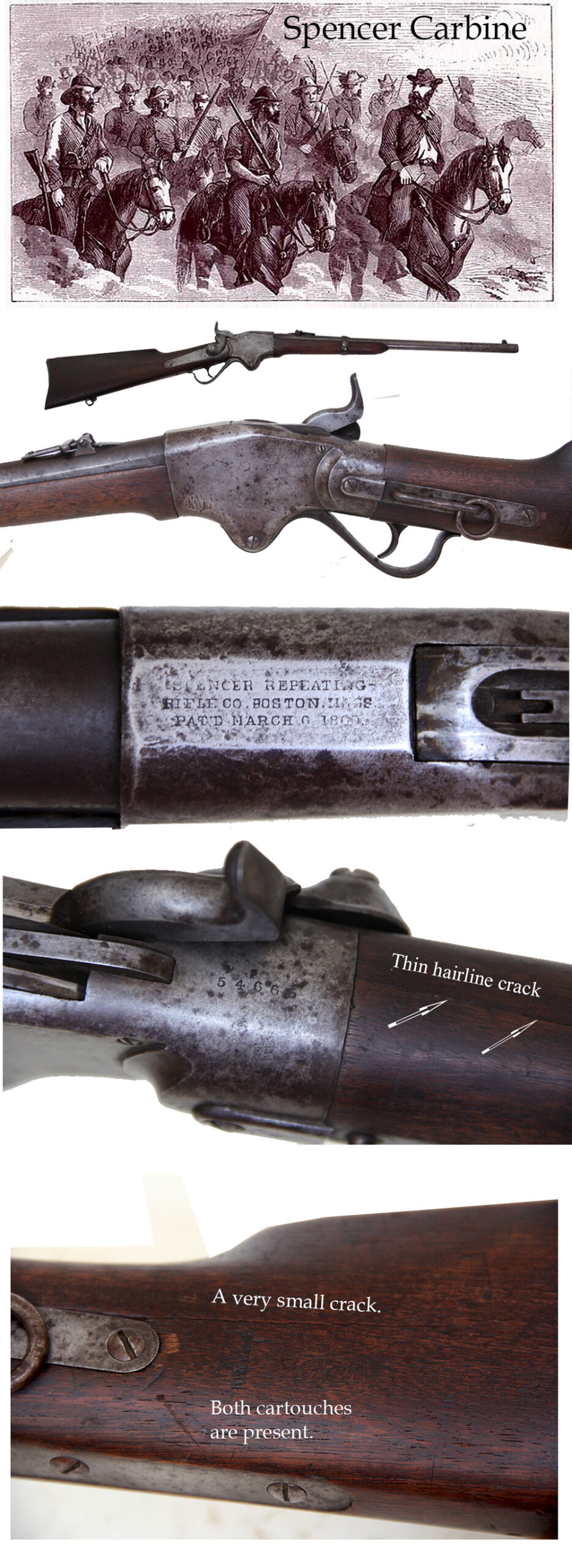
15-01-42 … Civil War Spencer Carbine …
This carbine has the standard 22″ barrel with 6 groove rifling and a VG bore. Serial number is 54665. Untouched delicate age patina, and a fine set of stocks with just two tiny hairline stress lines in the butt stock. Overall VG+++ condition… much nicer than most Spencers we find at the shows. Great edges on the wood, visible cartouches, no pitting. Really very nice. The gun is 100% original, 100% complete and mechanically perfect. These seven shot repeating carbines (and their cousins the famed Henry rifles) were the assault rifles of their day. The Confederates and in fact the rest of the world had nothing like these. The rebs cursed the troops armed with these saying “The Yankees loaded on Sunday and fired all week.” A very honest and very strong condition 1860 model Spencer carbine… just like Custer’s men carried
… $2,450.00 – SOLD
Click Here to E-mail Us!
Call us @ 419-842-1863

15-01-43 … A lot of TEN Original Indian War Large Size Eagle Coat Buttons.
A few years ago at an eastern Pennsylvania auction I bought a couple large bags full of these early Indian Fighters buttons and then I put them aside and forgot about them. I just stumbled across them again …. So here is a great opportunity…. ten original buttons for $25.00 These can be mailed inexpensively in a padded envelope.
… $25.00 for 10
Click Here to E-mail Us!
Call us @ 419-842-1863
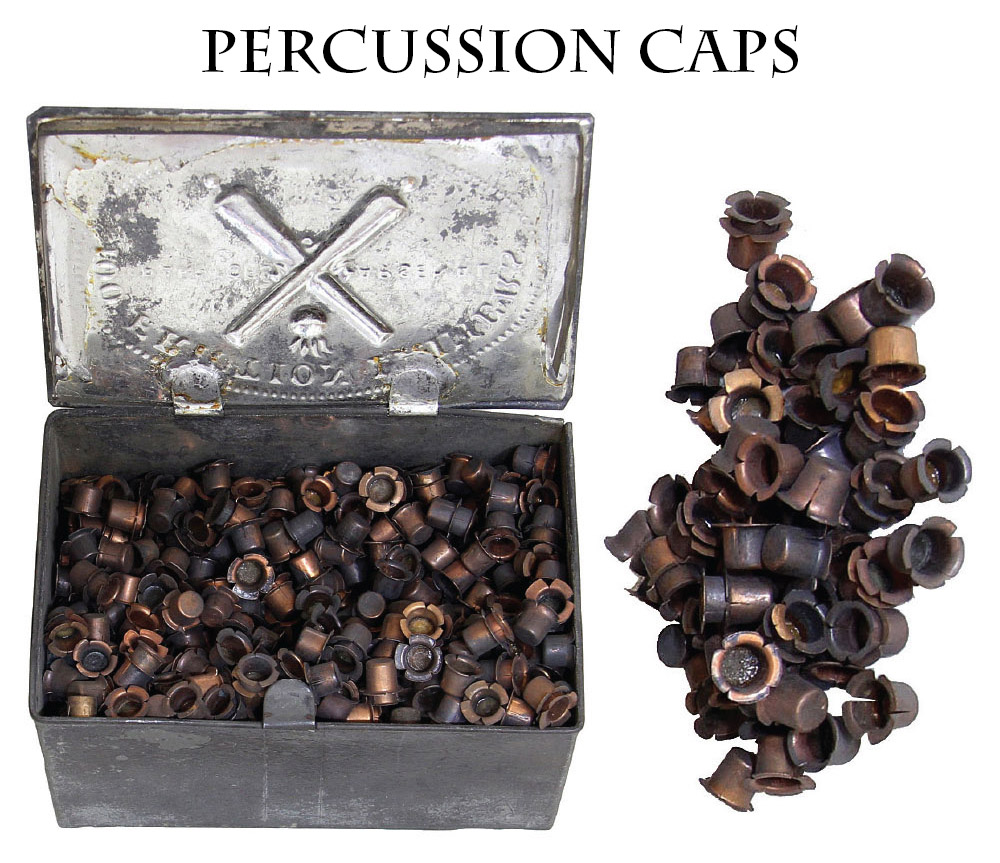
15-01-44 … Percussion Caps[Tin not for sale] …
I just purchased this neat old relic and am offering the percussion caps inside the tin in this offering. This very scarce tin came just as you see it, filled with percussion caps for muskets. The tin itself is the arsenal tin used to hold artillery friction primers. These are darned hard to find! I can only think of one instance where I found one still in a primer pouch! The tin has a hinged cover with small latch and embossed top reading: 100 FRICTION PRIMERS in an arc over an ordnance insignia, and FRANKFORD ARSENAL on either side. I don t know who put the percussion caps in the tin, it was certainly a handy storage idea, but since they do not belong together, I am splitting up the lot.
In each package of ten cartridges the soldier got 12 caps. While the supply lasts I will sell the percussion caps …
One Dozen … … … $15
Two Dozen … … … $25
Five dozen … … … $50
Click Here to E-mail Us!
Call us @ 419-842-1863

15-01-45 … These buttons were patented in 1862 by Abel Putnam
and made with a long spring shank and were designed to go through the grommets on issue rubber blankets so the sides could be connect ed and the whole thing worn as a poncho in rainy weather.The face is a standard Union Army eagle button. The back is a spring hook fashioned from double spring steel wire. I have very few priced each at
… $45.00
Click Here to E-mail Us!
Call us @ 419-842-1863
Layaways are Welcome
Need to split your order into multiple payments? No problem! A simple 20% earnest money deposit will hold your item for you.-acf
You can then pay it off in easy installments that fit your budget.
Read Terms Here
Items to Sell? Contact Us
I am always interested in buying ANYTHING from the American Civil War… Guns, Swords, Civil War Muskets, Knives, Uniforms, Flags, Medals, Badges, Diaries, Letters, Autographs, Buttons, photographs, tintypes, daguerreotypes, Insignia, Camp Items, Battlefield Relics, canteens, Drums, Etc… Call 419-842-1863 and ask for Dave Taylor.

